Microsoft RM-437 GSM/WCDMA cellular phone w/BT and WLAN User Manual Manual
Microsoft Mobile Oy GSM/WCDMA cellular phone w/BT and WLAN Manual
Contents
- 1. Manual
- 2. Manual rev
Manual
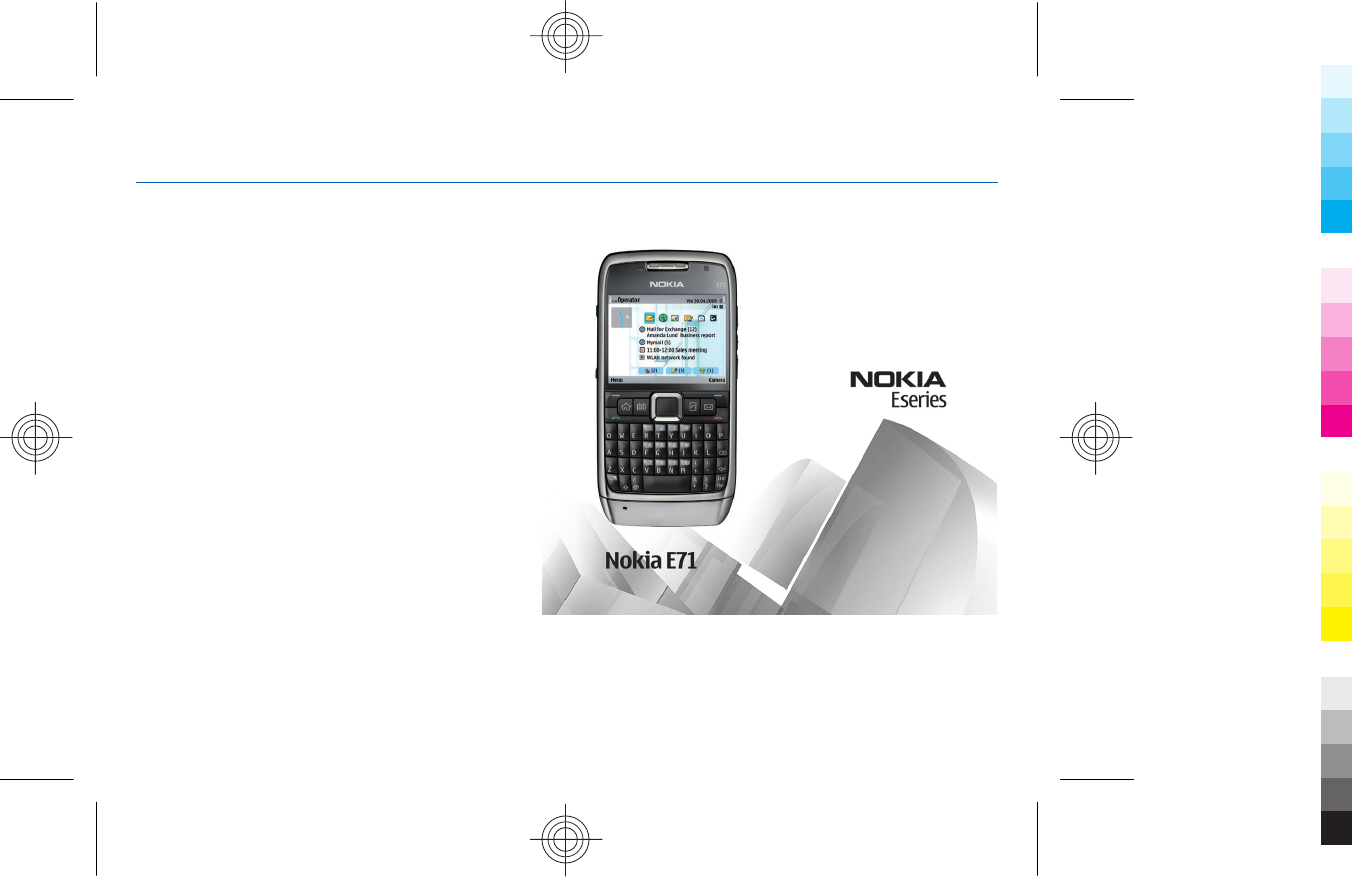
Nokia E63 User Guide
9211424
Issue 1
Cyan
Cyan
Magenta
Magenta
Yellow
Yellow
Black
Black

DECLARATION OF CONFORMITY
Hereby, NOKIA CORPORATION declares that this RM-437 product is in compliance with the essential requirements and other
relevant provisions of Directive 1999/5/EC. A copy of the Declaration of Conformity can be found at www.nokia.com/phones/
declaration_of_conformity/.
© 2008 Nokia. All rights reserved.
Nokia, Nokia Connecting People, Eseries, Nokia E63, and Visual Radio are trademarks or registered trademarks of Nokia Corporation. Nokia tune is a sound mark
of Nokia Corporation. Other product and company names mentioned herein may be trademarks or tradenames of their respective owners.
Reproduction, transfer, distribution, or storage of part or all of the contents in this document in any form without the prior written permission of Nokia is
prohibited.
US Patent No 5818437 and other pending patents. T9 text input software Copyright © 1997-2008. Tegic Communications, Inc. All rights reserved.
This product includes software licensed from Symbian Software Ltd ©1998-2008. Symbian and Symbian OS are trademarks of Symbian Ltd.
Java and all Java-based marks are trademarks or registered trademarks of Sun Microsystems, Inc.
Portions of the Nokia Maps software are ©1996-2008 The FreeType Project. All rights reserved.
This product is licensed under the MPEG-4 Visual Patent Portfolio License (i) for personal and noncommercial use in connection with information which has
been encoded in compliance with the MPEG-4 Visual Standard by a consumer engaged in a personal and noncommercial activity and (ii) for use in connection
with MPEG-4 video provided by a licensed video provider. No license is granted or shall be implied for any other use. Additional information, including that
related to promotional, internal, and commercial uses, may be obtained from MPEG LA, LLC. See http://www.mpegla.com
.
Nokia operates a policy of ongoing development. Nokia reserves the right to make changes and improvements to any of the products described in this document
without prior notice.
TO THE MAXIMUM EXTENT PERMITTED BY APPLICABLE LAW, UNDER NO CIRCUMSTANCES SHALL NOKIA OR ANY OF ITS LICENSORS BE RESPONSIBLE FOR ANY LOSS OF
DATA OR INCOME OR ANY SPECIAL, INCIDENTAL, CONSEQUENTIAL OR INDIRECT DAMAGES HOWSOEVER CAUSED.
THE CONTENTS OF THIS DOCUMENT ARE PROVIDED "AS IS". EXCEPT AS REQUIRED BY APPLICABLE LAW, NO WARRANTIES OF ANY KIND, EITHER EXPRESS OR IMPLIED,
INCLUDING, BUT NOT LIMITED TO, THE IMPLIED WARRANTIES OF MERCHANTABILITY AND FITNESS FOR A PARTICULAR PURPOSE, ARE MADE IN RELATION TO THE ACCURACY,
RELIABILITY OR CONTENTS OF THIS DOCUMENT. NOKIA RESERVES THE RIGHT TO REVISE THIS DOCUMENT OR WITHDRAW IT AT ANY TIME WITHOUT PRIOR NOTICE.
Reverse engineering of any software in the Nokia device is prohibited to the extent permitted by applicable law. Insofar as this user guide contains any limitations
on Nokia's representations, warranties, damages and liabilities, such limitations shall likewise limit any representations, warranties, damages and liabilities
of Nokia's licensors.
Cyan
Cyan
Magenta
Magenta
Yellow
Yellow
Black
Black
Cyan
Cyan
Magenta
Magenta
Yellow
Yellow
Black
Black

The availability of particular products and applications and services for these products may vary by region. Please check with your Nokia dealer for details, and
availability of language options.
Export controls
This device may contain commodities, technology or software subject to export laws and regulations from the US and other countries. Diversion contrary to
law is prohibited.
FCC/INDUSTRY CANADA NOTICE
Your device may cause TV or radio interference (for example, when using a telephone in close proximity to receiving equipment). The FCC or Industry Canada
can require you to stop using your telephone if such interference cannot be eliminated. If you require assistance, contact your local service facility. This device
complies with part 15 of the FCC rules. Operation is subject to the following two conditions: (1) This device may not cause harmful interference, and (2) this
device must accept any interference received, including interference that may cause undesired operation. Any changes or modifications not expressly approved
by Nokia could void the user's authority to operate this equipment.
9211424/Issue 1
Cyan
Cyan
Magenta
Magenta
Yellow
Yellow
Black
Black
Cyan
Cyan
Magenta
Magenta
Yellow
Yellow
Black
Black

Contents
Safety................................................................6
About your device.................................................................6
Network services...................................................................7
Key features.....................................................8
New from Eseries..............................................9
Access tasks quickly..............................................................9
Home screen..........................................................................9
One-touch keys...................................................................10
Nokia Calendar for Eseries.................................................11
Nokia Contacts for Eseries..................................................12
Multitasking.........................................................................14
Flashlight.............................................................................14
Open Ovi with Nokia E63 ...................................................14
Files on Ovi..........................................................................14
My Nokia..............................................................................15
Phone.............................................................16
Voice calls............................................................................16
Video calls............................................................................17
Net calls...............................................................................18
Speed dialling.....................................................................20
Voice mail............................................................................20
Messaging.......................................................21
E-mail messages.................................................................21
Write and send text messages..........................................25
Text message settings........................................................25
Multimedia messages.........................................................26
Instant messaging..............................................................27
Internet..........................................................28
Web......................................................................................28
Browse the intranet ..........................................................29
Download!...........................................................................30
Internet access points........................................................30
Connect PC to web..............................................................31
Maps...............................................................33
About Maps..........................................................................33
Move on a map....................................................................34
Display indicators...............................................................34
Find locations......................................................................34
Plan a route.........................................................................35
Media..............................................................36
Camera.................................................................................36
Music player.........................................................................37
Share online........................................................................38
Recorder..............................................................................38
Gallery..................................................................................38
Flash player.........................................................................39
Radio....................................................................................39
Internet radio......................................................................39
Personalisation..............................................42
Profiles.................................................................................42
Select ringing tones............................................................42
Personalise the home screen............................................43
Contents
Cyan
Cyan
Magenta
Magenta
Yellow
Yellow
Black
Black
Cyan
Cyan
Magenta
Magenta
Yellow
Yellow
Black
Black

Change the display theme.................................................43
Nokia Office Tools...........................................44
Active notes ........................................................................44
Calculator.............................................................................44
File manager.......................................................................45
Quickoffice...........................................................................45
Converter.............................................................................45
Zip manager........................................................................46
PDF reader...........................................................................46
Printing ...............................................................................46
Clock.....................................................................................47
Connectivity....................................................48
Data cable............................................................................48
Bluetooth.............................................................................48
Wireless LAN........................................................................50
Connection manager..........................................................52
Security and data management.....................54
Lock the device...................................................................54
Memory................................................................................54
Memory card security.........................................................55
Encryption...........................................................................56
Certificate manager............................................................56
Back up data........................................................................57
Application manager..........................................................58
Data synchronisation.........................................................59
Mobile VPN...........................................................................59
Settings..........................................................61
General settings..................................................................61
Telephone settings.............................................................64
Connection settings............................................................65
Application settings............................................................67
Shortcuts........................................................68
General shortcuts................................................................68
Enhancements................................................69
Battery and charger information...................70
Battery and charger information......................................70
Nokia battery authentication guidelines.........................71
Care and maintenance....................................73
Disposal................................................................................73
Additional safety information.......................75
Small children.....................................................................75
Operating environment.....................................................75
Medical devices...................................................................75
Vehicles................................................................................76
Potentially explosive environments.................................76
Emergency calls...................................................................77
Certification information (SAR).........................................77
Index..............................................................79
Contents
Cyan
Cyan
Magenta
Magenta
Yellow
Yellow
Black
Black
Cyan
Cyan
Magenta
Magenta
Yellow
Yellow
Black
Black

Safety
Read these simple guidelines. Not following them may be
dangerous or illegal. Read the complete user guide for
further information.
SWITCH ON SAFELY
Do not switch the device on when wireless
phone use is prohibited or when it may cause
interference or danger.
INTERFERENCE
All wireless devices may be susceptible to
interference, which could affect performance.
SWITCH OFF IN RESTRICTED AREAS
Follow any restrictions. Switch the device off in
aircraft, near medical equipment, fuel,
chemicals, or blasting areas.
QUALIFIED SERVICE
Only qualified personnel may install or repair
this product.
ENHANCEMENTS AND BATTERIES
Use only approved enhancements and
batteries. Do not connect incompatible
products.
WATER-RESISTANCE
Your device is not water-resistant. Keep it dry.
About your device
The wireless device described in this guide is approved for
use on the (E)GSM 850, 900, 1800, and 1900 networks, and
UMTS 900/2100 networks. Contact your service provider
for more information about networks.
When using the features in this device, obey all laws and
respect local customs, privacy and legitimate rights of
others, including copyrights.
Copyright protection may prevent some images, music,
and other content from being copied, modified, or
transferred.
Your device supports several methods of connectivity. Like
computers, your device may be exposed to viruses and
other harmful content. Exercise caution with messages,
connectivity requests, browsing, and downloads. Only
install and use services and other software from
trustworthy sources that offer adequate security and
protection against harmful software, such as applications
that are Symbian Signed or have passed the Java Verified™
testing. Consider installing antivirus and other security
software on your device and any connected computer.
Your device may have preinstalled bookmarks and links for
third-party internet sites. You may also access other third-
party sites through your device. Third-party sites are not
affiliated with Nokia, and Nokia does not endorse or
6
Safety
Cyan
Cyan
Magenta
Magenta
Yellow
Yellow
Black
Black
Cyan
Cyan
Magenta
Magenta
Yellow
Yellow
Black
Black

assume liability for them. If you choose to access such
sites, you should take precautions for security or content.
Warning: To use any features in this device, other
than the alarm clock, the device must be switched on. Do
not switch the device on when wireless device use may
cause interference or danger.
The office applications support common features of
Microsoft Word, PowerPoint, and Excel (Microsoft Office
2000, XP, and 2003). Not all file formats can be viewed or
modified.
Remember to make back-up copies or keep a written
record of all important information stored in your device.
When connecting to any other device, read its user guide
for detailed safety instructions. Do not connect
incompatible products.
The images in this guide may differ from your device
display.
Network services
To use the device you must have service from a wireless
service provider. Many of the features require special
network features. These features are not available on all
networks; other networks may require that you make
specific arrangements with your service provider before
you can use the network services. Using network services
involves transmission of data. Check with your service
provider for details about fees in your home network and
when roaming on other networks. Your service provider
can give you instructions and explain what charges will
apply. Some networks may have limitations that affect
how you can use network services. For instance, some
networks may not support all language-dependent
characters and services.
Your service provider may have requested that certain
features be disabled or not activated in your device. If so,
these features will not appear on your device menu. Your
device may also have a special configuration such as
changes in menu names, menu order, and icons. Contact
your service provider for more information.
This device supports WAP 2.0 protocols (HTTP and SSL) that
run on TCP/IP protocols. Some features of this device, such
as e-mail, browsing, and multimedia messaging (MMS),
require network support for these technologies.
7
Safety
Cyan
Cyan
Magenta
Magenta
Yellow
Yellow
Black
Black
Cyan
Cyan
Magenta
Magenta
Yellow
Yellow
Black
Black
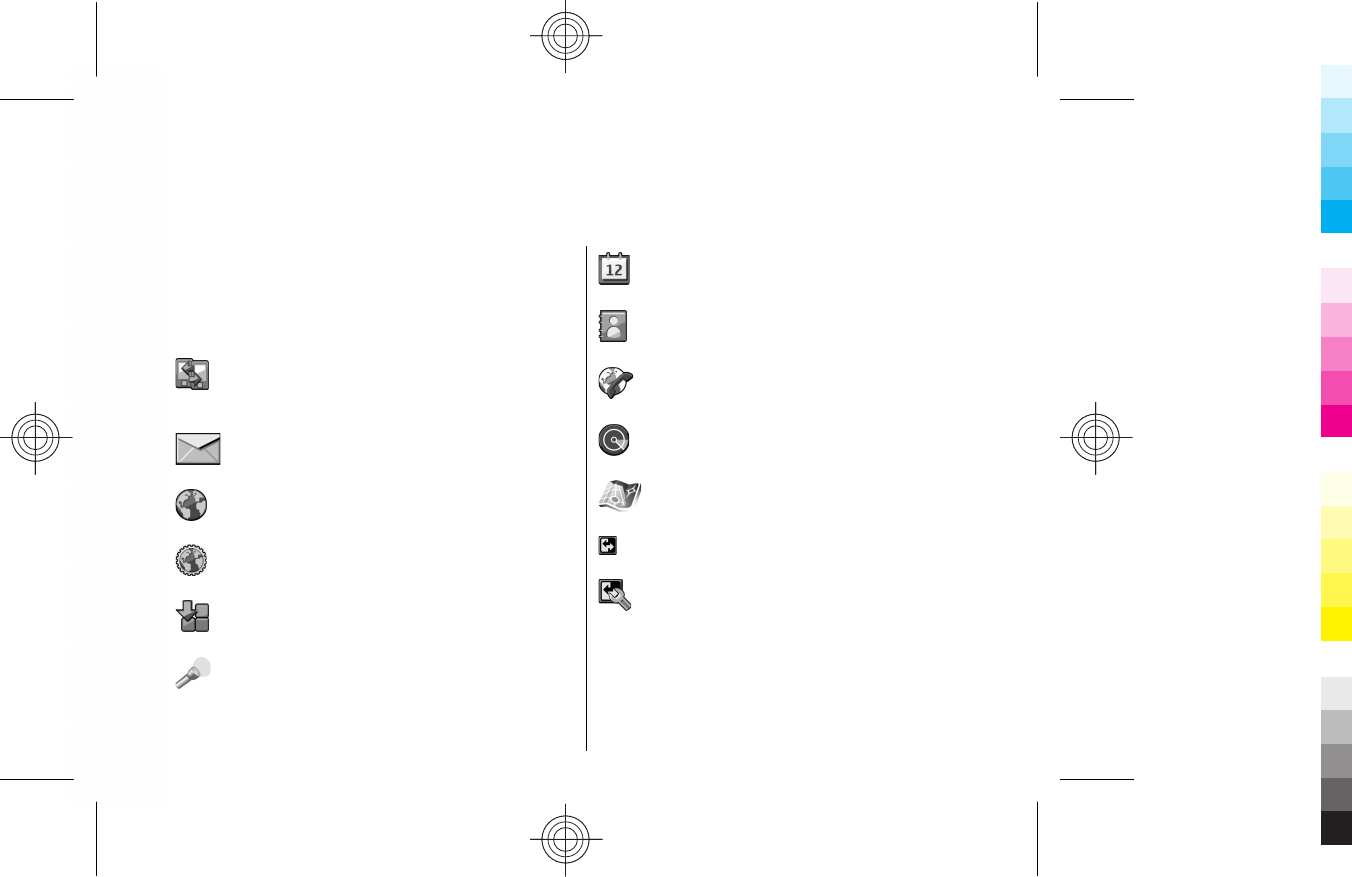
Key features
Model number: Nokia E63-1 (RM-437).
Hereinafter referred to as Nokia E63.
Your new Nokia E63 helps you manage your business and
personal information. Some of the key features are
highlighted here:
Move your contact and calendar information
from a previous device to your Nokia E63 with
Switch.
Receive and send messages while on the move.
Browse the internet with Web.
Browse your company intranet with Intranet.
Add new applications to your Nokia E63 with
Download!.
Use your device as a flashlight.
Stay up-to-date and plan your meetings with
Calendar.
Manage your business partners and free time
friends with the new Contacts application.
Make calls using voice over IP services with
Internet tel..
Connect to WLAN with WLAN wizard.
Find points of interest with Maps.
Switch from business to personal mode.
Edit the appearance and setup of your home
screen with Modes.
8
Key features
Cyan
Cyan
Magenta
Magenta
Yellow
Yellow
Black
Black
Cyan
Cyan
Magenta
Magenta
Yellow
Yellow
Black
Black
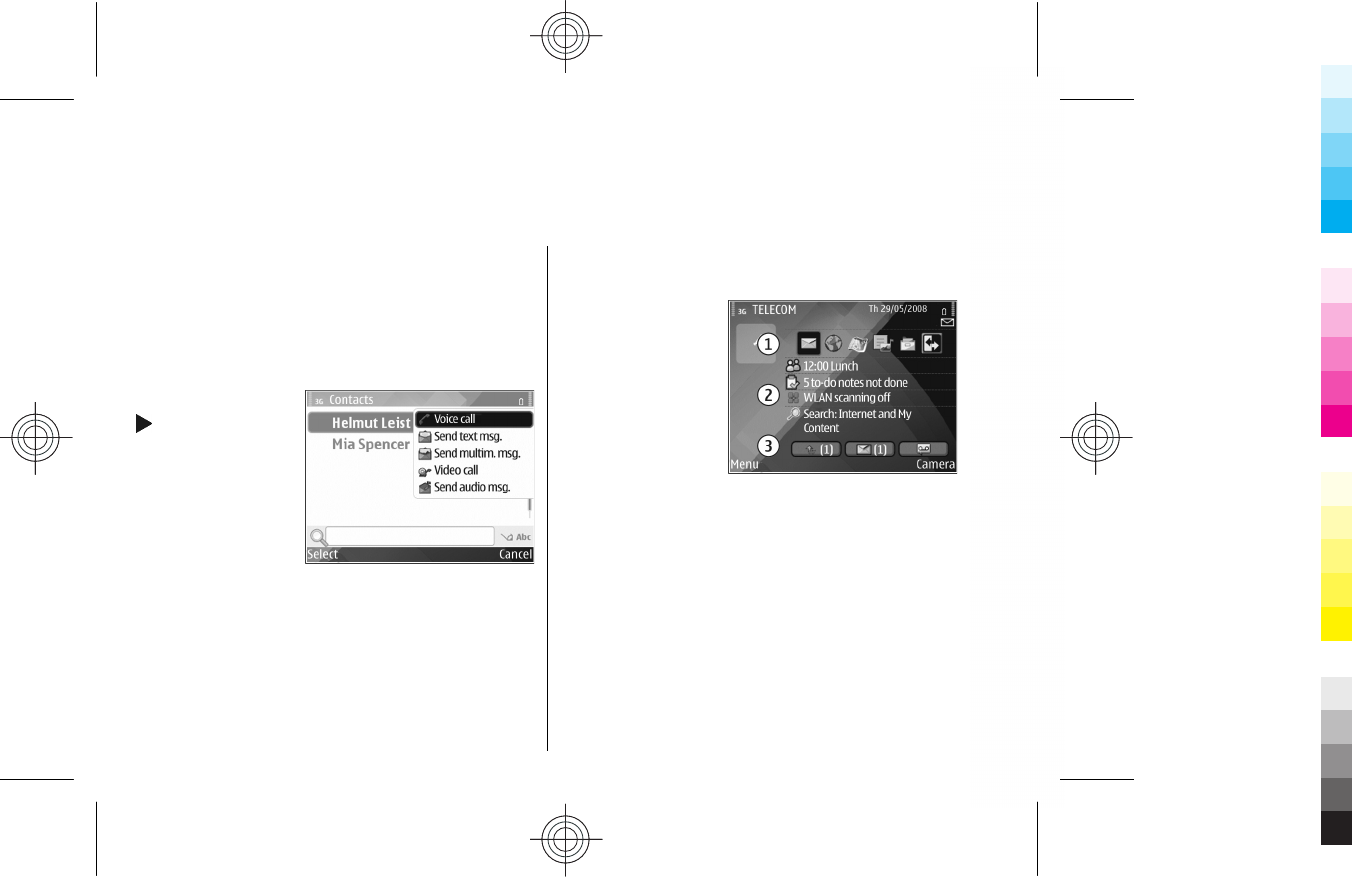
New from Eseries
Your new Eseries device contains new versions of the
Calendar and Contacts applications, as well as a new home
screen. You can also access the Ovi services with your
device.
Access tasks quickly
Whenever you see the
icon on the home
screen, or in the
Contacts or Calendar
applications, scroll
right to access a list of
available actions. To
close the list, scroll left.
When you navigate in
these applications, to
go back to the previous level, scroll left.
Home screen
From the home screen you can quickly access features that
you use the most, and see at a glance any missed calls or
new messages.
Navigate in the home screen
To access the home screen, press the home key briefly.
The home screen
consists of:
•application
shortcuts (1) To
access an
application quickly,
scroll to its shortcut
and press the scroll
key.
•information area (2)
To check an item displayed in the information area,
scroll to the item and press the scroll key.
•notifications (3) To view the notifications, scroll to a
box. Each box is only visible if there are items in it. To
hide the boxes, press the backspace key.
To define what kind of items and shortcuts you want to
see on the home screen, and to set the appearance of the
home screen, select Menu > Tools > Modes.
Work on the home screen
To search for contacts in the home screen, start entering
the contact's name. The device suggests matching 9
New from Eseries
Cyan
Cyan
Magenta
Magenta
Yellow
Yellow
Black
Black
Cyan
Cyan
Magenta
Magenta
Yellow
Yellow
Black
Black

contacts. Scroll to the desired contact. This feature may
not be available in all languages.
To call the contact, press the call key.
To set off the contact search, select Options > Contact
search off.
To check your received messages, scroll to the message
box in the notification area. To read a message, scroll to it
and press the scroll key. To access other tasks, scroll right.
To view your missed calls, scroll to the calls box in the
notification area. To return a call, scroll to a call and press
the call key. To send a text message to a caller, scroll to a
call, scroll right and select Send text msg. from the list of
available actions.
To listen to your voice mail, scroll to the voice mail box in
the notification area. Scroll to the desired voice mailbox
and press the call key to call it.
Switch home screens
You can define two home screen modes for different
purposes, such as one mode to show your business e-mail
and notifications, and another to show your personal e-
mail. This way, you do not have to see business-related
messages outside office hours.
Your operator may have set you a third home screen with
operator-specific items.
To change from one home screen mode to another, scroll
to and press the scroll key.
One-touch keys
With the One-touch keys you can access applications and
tasks quickly. Each key has been assigned an application
and a task. To change these, select Menu > Tools >
Settings > General > Personalisation > One-touch
keys. Your network operator may have assigned
applications to the keys, in which case you cannot change
them.
Home key
To access the home screen, press the home key briefly.
Press the home key briefly again to access the menu.
To view the list of active applications, press the home key
for a few seconds. When the list is open, press the home
key briefly to scroll the list. To open the selected
application, press the home key for a few seconds, or press
the scroll key. To close the selected application, press the
backspace key.
Leaving applications running in the background increases
the demand on battery power and reduces the battery life.
Contacts key
To open the Contacts application, press the contacts key
briefly.
To create a new contact, press the contacts key for a few
seconds.
10
New from Eseries
Cyan
Cyan
Magenta
Magenta
Yellow
Yellow
Black
Black
Cyan
Cyan
Magenta
Magenta
Yellow
Yellow
Black
Black
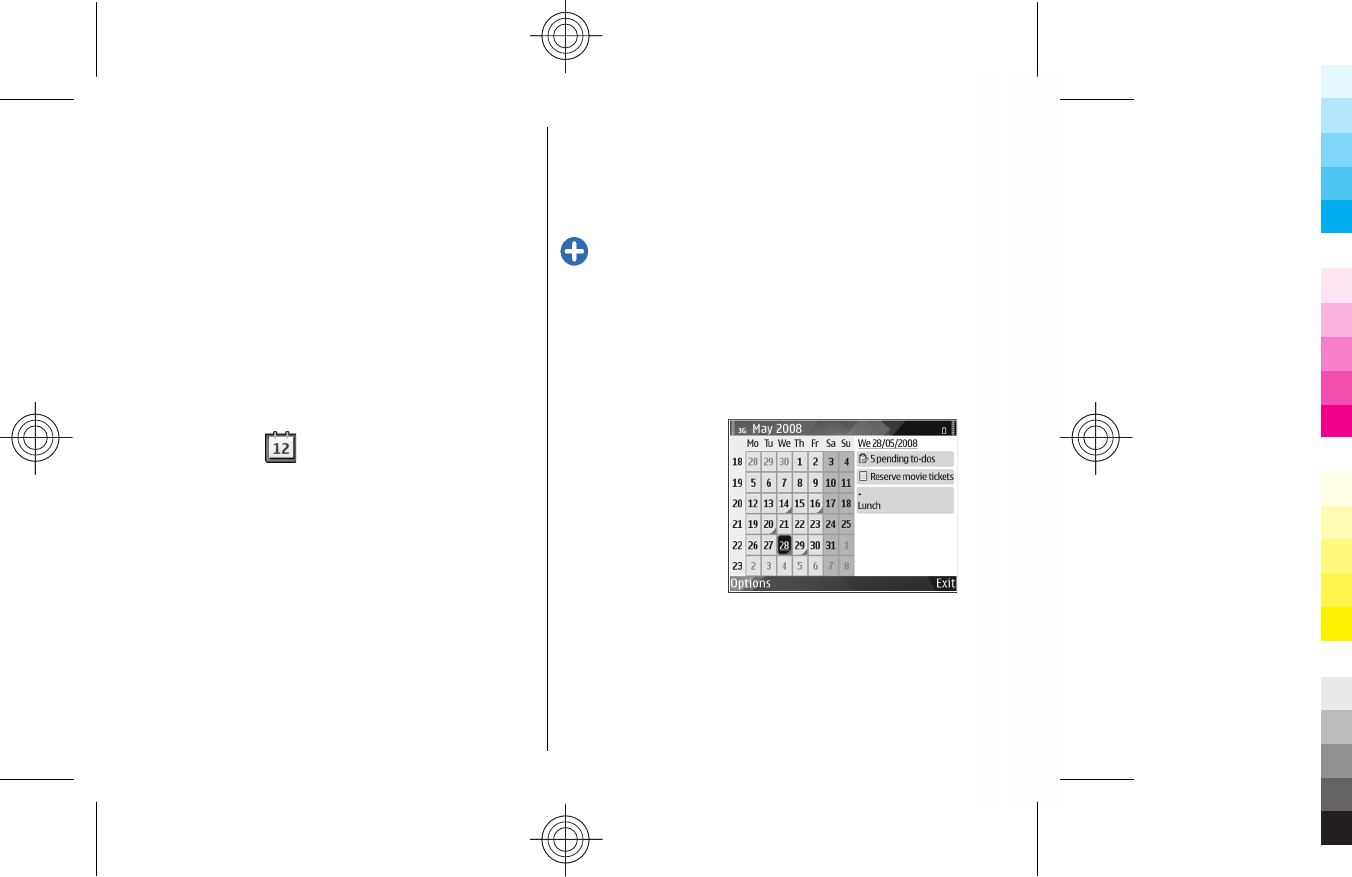
Calendar key
To open the Calendar application, press the calendar key
briefly.
To create a new meeting entry, press the calendar key for
a few seconds.
E-mail key
To open your default mailbox, press the e-mail key briefly.
To create a new e-mail message, press the e-mail key for
a few seconds.
Nokia Calendar for
Eseries
Select Menu > Office > Calendar.
Create and view scheduled events and appointments, and
switch between different calendar views.
Calendar views
You can switch between the following views:
•Month view shows the current month and the calendar
entries of the selected day in a list.
•Week view shows the events for the selected week in
seven day boxes.
•Day view shows the events for the selected day grouped
into time slots according to their starting time.
•To-do view shows all to-do items.
•Agenda view shows the events for the selected day in
a list.
To change the view, select Options > Change view and
the desired view.
Tip: To open the week view, scroll to a week number
and press the scroll key.
To move to the next or the previous day in month, week,
day, and agenda views, scroll right or left.
To change the default view, select Options > Settings >
Default view.
View calendar information
In the month view,
calendar entries are
marked with a triangle.
Anniversary entries are
also marked with an
exclamation mark. The
entries of the selected
day are shown in a list.
To open calendar
entries, open a
calendar view, scroll to
an entry, and press the scroll key.
Create calendar entries
You can create the following types of calendar entries: 11
New from Eseries
Cyan
Cyan
Magenta
Magenta
Yellow
Yellow
Black
Black
Cyan
Cyan
Magenta
Magenta
Yellow
Yellow
Black
Black

•Meeting entries remind you of events that have a
specific date and time.
•Memo entries are related to the whole day but not to a
specific time of the day.
•Anniversary entries remind you of birthdays and special
dates. They refer to a certain day but not a specific time
of the day. Anniversary entries are repeated every year.
•To-do entries remind you of a task that has a due date
but not a specific time of the day.
To create a calendar entry, scroll to a date, select
Options > New entry and the entry type.
Tip: To create a meeting entry, start entering the
subject.
Create meeting, memo, anniversary, or to-do
entries
1. Enter the subject.
2. For meeting entries, enter the start and end times, or
select All-day event.
3. For meeting and memo entries, enter the start and end
dates. For anniversary entries, enter the date and for
to-do entries, enter the due date.
4. For meeting entries, enter the location.
5. For meeting, anniversary, and to-do entries, you can
set an alarm.
6. For recurring meeting entries, set the recurrence time.
7. For to-do entries, set the priority. To set the priority for
meeting entries, select Options > Priority.
8. For memo, anniversary, and to-do entries, define how
the entry is handled during synchronisation. Select
Private to hide the entry from viewers if the calendar
is available online, Public to make the entry visible to
viewers, or None to not copy the entry to your
computer.
9. Enter a description.
To send the entry, select Options > Send.
Calendar settings
Select Options > Settings.
To change the alarm tone, select Calendar alarm tone.
To change the view displayed when you open the
calendar, select Default view.
To change the first day of the week, select Week starts
on.
To change the week view title, select Week view title and
Week number or Week dates.
Nokia Contacts for
Eseries
Select Menu > Communic. > Contacts.
Save and update contact information, such as phone
numbers, home addresses, or e-mail addresses of your
contacts. You can add a personal ringing tone or a
thumbnail image to a contact. You can also create contact
groups, which allow you to communicate with several
contacts at the same time, and send contact information
(business cards) to or receive it from compatible devices.
12
New from Eseries
Cyan
Cyan
Magenta
Magenta
Yellow
Yellow
Black
Black
Cyan
Cyan
Magenta
Magenta
Yellow
Yellow
Black
Black

Whenever you see the icon, scroll right to access a list
of available actions. To close the list, scroll left.
Add contacts
Select Options > New contact, and enter the contact's
information.
To copy a contact's information from the memory card,
select Options > Copy > From memory card.
Contact groups
Select each contact you want to add to the contact group,
select Options > Mark/Unmark > Mark to mark it,
select Options > Group > Add to group > Create new
group > Group name, and enter a name for the group.
If you want to make conference calls to the group, define
also the following:
•Conf. service number — Enter the conference call
service number.
•Conf. service ID — Enter the conference call ID number.
•Conf. service PIN — Enter the conference call PIN code
number.
To make a conference call to the group, select the group,
scroll right, and select Call conf. service from the list of
available actions.
Search for contacts
To search for contacts, start entering the contact's name
in the search field.
Manage contacts directories
You can install contacts directories from the Download!
application.
To change the contacts directory, scroll to the top of the
names list, press the scroll key, and select from the list of
available directories.
To organise contacts directories, select Options >
Organise contact lists and a directory. Scroll up to move
it to the desired place.
Add ringing tones for contacts
You can set a ringing tone for a contact or contact group.
The ringing tone sounds when the contact calls you.
To add a ringing tone for contacts, open a contact, select
Options > Ringing tone and a ringing tone.
To add a ringing tone for contact groups, select a contact
group, Options > Group > Ringing tone and a ringing
tone.
To remove the assigned ringing tone, select Default
tone from the list of ringing tones.
Change contacts settings
Select Options > Settings.
To change the way the contacts' names are displayed,
select Name display.
To select which contacts directory opens when you open
the Contacts application, select Default contact list.13
New from Eseries
Cyan
Cyan
Magenta
Magenta
Yellow
Yellow
Black
Black
Cyan
Cyan
Magenta
Magenta
Yellow
Yellow
Black
Black

Multitasking
You can have several applications open at the same time.
To switch between active applications, press and hold the
home key, scroll to an application, and press the scroll key.
To close the selected application, press the backspace key.
Example: When you have an active phone call and
want to check your calendar, press the home key to
access the menu, and open the Calendar
application. The phone call remains active in the
background.
Example: When you are writing a message and
want to check a web site, press the home key to
access the menu, and open the Web application.
Select a bookmark or enter the web address
manually, and select Go to. To return to your
message, press and hold the home key, scroll to the
message and press the scroll key.
Flashlight
The camera flash can be used as a flashlight. To switch the
flashlight on or off, in the home screen, press and hold the
space bar.
Open Ovi with Nokia
E63
Ovi is your door to different Nokia services.
For a tour and more information, browse to
www.ovi.com with your computer.
Files on Ovi
With Files on Ovi, you can use your Nokia E63 to access
content on your computer if it is switched on and
connected to the internet. You will need to install the Files
on Ovi application to every computer you want to access
with Files on Ovi.
Using Files on Ovi, you can:
•Browse, search, and view your photos. You do not need
to upload the photos to the website but you can access
your computer content with your mobile device.
•Browse, search, and view your files and documents. You
do not need any special applications on your device.
•Download music tracks from your computer to your
device. Later, you can use the music player on your
device to listen the tracks as you normally would.
•Send files and folders from your computer without
moving them to and from your device first.
•Access files on your computer even when your
computer is switched off. Just choose which folders and
files you want to be available, and Files on Ovi
automatically keeps an up-to-date copy stored in a
secure, online storage for access anytime.
To install Files on Ovi:
1. Open Start Files.
2. Read the information on the display, and select
Continue.
14
New from Eseries
Cyan
Cyan
Magenta
Magenta
Yellow
Yellow
Black
Black
Cyan
Cyan
Magenta
Magenta
Yellow
Yellow
Black
Black

3. Scroll down to the Email field, and press the scroll key
to activate it.
4. Enter your e-mail address, and select Done.
5. Select Send. The Files on Ovi service sends you an e-
mail with get started information.
For support, browse tohttp://support.files.ovi.com/
support.
My Nokia
My Nokia is a free service that regularly sends you text
messages containing tips, tricks, and support for your
Nokia device. It also allows you to browse the My Nokia
WAP site where you can find details about Nokia devices
and download tones, graphics, games, and applications.
To use the My Nokia service, it must be available in your
country and supported by your service provider. You must
sign up to use the service.
Call charges apply when you send messages to sign up or
unsubscribe.
For terms and conditions, see the documentation supplied
with your device, or www.nokia.com/mynokia.
To start using My Nokia:
1. Select My Nokia.
2. Select Register to My Nokia.
3. Read the information on the display, and select
Accept.
My Nokia sends you a text message with further
instructions.
To launch the My Nokia WAP site in your browser, select
My Nokia > Go to My Nokia.
To unsubscribe from the My Nokia service, select My
Nokia > Unsubscribe.
To see the instructions for My Nokia, select My Nokia >
Help.
15
New from Eseries
Cyan
Cyan
Magenta
Magenta
Yellow
Yellow
Black
Black
Cyan
Cyan
Magenta
Magenta
Yellow
Yellow
Black
Black

Phone
To make and receive calls, the device must be switched on,
the device must have a valid SIM card installed, and you
must be located in the service area of a cellular network.
To make or receive a net call, your device must be
connected to a net call service. To connect to a net call
service, your device must be in the coverage of a
connection network, such as a WLAN access point.
Voice calls
Note: The actual invoice for calls and services from
your service provider may vary, depending on network
features, rounding off for billing, taxes, and so forth.
Answer a call
To answer a call, press the call key.
To reject a call, press the end key.
To mute the ringing tone instead of answering a call, select
Silence.
When you have an active call and the call waiting function
(network service) is activated, press the call key to answer
a new incoming call. The first call is put on hold. To end
the active call, press the end key.
Make a call
Important: If the device has been locked, enter the
lock code to activate the phone function. When the device
is locked, calls may be possible to the official emergency
number. Making an emergency call in the offline profile or
when the device is locked requires that the device
recognise the number to be an official emergency number.
It is advisable to change the profile or unlock the device
by entering the lock code before you make the emergency
call.
To make a call, enter the phone number, including the area
code, and press the call key.
Tip: For international calls, add the + character that
replaces the international access code, and enter
the country code, area code (omit the leading 0, if
necessary), and phone number.
To end the call or cancel the call attempt, press the end
key.
To make a call using the saved contacts, press the contacts
key. Enter the first letters of the name, scroll to the name,
and press the call key. See "Nokia Contacts for
Eseries", p. 12.
To make a call using the log, press the call key to view up
to 20 numbers that you last called or attempted to call.
16
Phone
Cyan
Cyan
Magenta
Magenta
Yellow
Yellow
Black
Black
Cyan
Cyan
Magenta
Magenta
Yellow
Yellow
Black
Black

Scroll to the desired number or name, and press the call
key.
To adjust the volume of an active call, scroll right or left.
To switch from a voice call to a video call, select Options >
Switch to video call. The device ends the voice call and
makes a video call to the recipient.
Make a conference call
1. To make a conference call, enter a participant's phone
number, and press the call key.
2. When the participant answers, select Options > New
call.
3. When you have made a phone call to all the
participants, select Options > Conference to merge
the calls into a conference call.
To mute the microphone of your device during the call,
select Options > Mute.
To drop a participant from the conference call, scroll to the
participant, and select Options > Conference > Drop
participant.
To discuss privately with a conference call participant,
scroll to the participant, and select Options >
Conference > Private.
Video calls
To be able to make a video call, you need to be in the
coverage of a UMTS network. For availability of and
subscription to video call services, contact your network
operator or service provider. While talking, you can see a
real-time, two-way video between you and the recipient
of the call, if the recipient has a compatible mobile phone.
The video image captured by the camera in your device is
shown to the video call recipient. A video call can only be
made between two parties.
Make a video call
Warning: Do not hold the device near your ear when
the loudspeaker is in use, because the volume may be
extremely loud.
To make a video call, enter the phone number or select the
recipient of the call from Contacts, and select Options >
Call > Video call. When the video call starts, the camera
of the device is activated. If the camera is already in use,
video sending is disabled. If the recipient of the call does
not want to send a video back to you, a still image is shown
instead. You can define the still image in Menu > Tools >
Settings > Phone > Call > Image in video call.
To disable the sending of audio, video, or video and audio,
select Options > Disable > Sending audio, Sending
video, or Sending aud. & video.
To adjust the volume of an active video call, scroll right or
left.
To use the loudspeaker for receiving audio, select
Options > Activate loudspeaker. To mute the
loudspeaker and use the earpiece, select Options >
Activate handset.
To swap the places of images, select Options > Change
image order.17
Phone
Cyan
Cyan
Magenta
Magenta
Yellow
Yellow
Black
Black
Cyan
Cyan
Magenta
Magenta
Yellow
Yellow
Black
Black

To zoom the image on the display, select Options >
Zoom in or Zoom out.
To end the video call and make a new voice call to the same
recipient, select Options > Switch to voice call.
Share a video
Use Video sharing (network service) to send live video or
a video clip from your mobile device to another
compatible mobile device during a voice call. To use this
feature, the device must be within the coverage of a UMTS
network.
1. Make a phone call to the selected recipient. You can
start sharing a video once the phone call is established
and your device has been registered to the SIP server.
2. To send live video or a video clip from your device,
select Options > Share video > Live or Clip. To
preview the clip, select Options > Play.
3. Select the recipient from Contacts, or enter the
recipient's SIP address manually to send an invitation
to the recipient. Sharing begins automatically when
the recipient accepts the video sharing.
4. To end sharing the video, select Stop. The voice call
continues normally.
Receive a video sharing
invitation
When you receive a video sharing invitation, a message is
displayed showing the caller's name or SIP address.
To accept the invitation and begin the sharing session,
select Accept.
To reject the invitation, select Reject. The voice call
continues normally.
Net calls
Select Menu > Communic. > Internet tel..
Your device supports voice calls over the internet (net
calls). Your device attempts emergency calls primarily over
cellular networks. If an emergency call using cellular
networks is not successful, your device attempts an
emergency call through your net call provider. Due to the
established nature of cellular telephony, you should use
cellular networks for emergency calls, if possible. If you
have cellular network coverage available, make sure that
your cellular phone is switched on and ready to make calls
before you attempt an emergency call. The capability for
an emergency call using internet telephony depends on
the availability of a WLAN and your net call provider's
implementation of emergency call capabilities. Contact
your net call provider to check the internet telephony
emergency call capability.
With the net call service (network service), you can make
and receive calls over the internet using the VoIP (voice
over internet protocol) technology. Net calls can be
established between computers, between mobile phones,
and between a VoIP device and a traditional telephone. To
make or receive a net call, your device must be within
WLAN coverage, for example. The availability of the net call
service may vary according to your country or area.
18
Phone
Cyan
Cyan
Magenta
Magenta
Yellow
Yellow
Black
Black
Cyan
Cyan
Magenta
Magenta
Yellow
Yellow
Black
Black

Create a net call profile
Before you can make net calls, you need to create a net call
profile.
1. Select Menu > Tools > Settings > Connection >
SIP settings > Options > New SIP profile, and enter
the required information. To make the login to the net
call service automatic, select Registration > Always
on. Contact your net call provider for the correct
settings.
2. Select Back until you return to the Connection settings
main view.
3. Select Internet tel. > Options > New profile. Enter
a name for the profile, and select the SIP profile you
just created.
To set the created profile to be used automatically when
connecting to the net call service, select Menu >
Communic. > Internet tel. > Preferred profile.
To login to the net call service manually, select
Registration > When needed in the SIP settings when
creating a net call profile.
To make secure net calls, ask your service provider for
secure net call settings. The proxy server selected for the
net call profile must support secure net calls. A secure net
call is indicated with .
Connect to the net call service
Select Menu > Communic. > Internet tel..
To make or receive a net call, your device must be
connected to a net call service. If you have selected
automatic login, your device automatically connects to the
net call service. If you login to the service manually, select
an available network from the list and Select.
The list of networks is refreshed automatically every 15
seconds. To refresh the list manually, select Options >
Refresh. Use this option if your WLAN is not shown on the
list.
To select a net call service for outgoing calls if the device
is connected to more than one service, select Options >
Change service.
To configure new services, select Options > Configure
service. This option is shown only if there are services that
have not been configured.
To save the network to which you are currently connected,
select Options > Save network. The saved networks are
marked with a star on the list of networks.
To connect to a net call service using a hidden WLAN, select
Options > Use hidden network.
To end the connection to a net call service, select
Options > Disconnect from service.
Make net calls
You can make a net call from all applications where you
can make a regular voice call. For example in Contacts,
scroll to the desired contact, and select Call > Internet
call.
To make a net call in the home screen, enter the SIP
address, and press the call key.
To set net call as the preferred call type for outgoing calls,
select Menu > Communic. > Internet tel. > Options >
Settings > Default call type > Internet call. When your
19
Phone
Cyan
Cyan
Magenta
Magenta
Yellow
Yellow
Black
Black
Cyan
Cyan
Magenta
Magenta
Yellow
Yellow
Black
Black

device is connected to a net call service, all calls are made
as net calls.
Speed dialling
Select Menu > Tools > Settings > Phone > Call >
Speed dialling > On.
Speed dialling allows you to make a call by pressing and
holding a number key when in the home screen.
To assign a number key to a phone number, select Menu >
Communic. > Speed dial. Scroll to the number key (2 -
9) on the display, and select Options > Assign. Select the
desired number from Contacts.
To delete the phone number assigned to a number key,
scroll to the speed dialling key, and select Options >
Remove.
To modify a phone number assigned to a number key,
scroll to the speed dialling key, and select Options >
Change.
Voice mail
Select Menu > Communic. > Call mailbox.
When you open the Voice mail application for the first
time, you are asked to enter the number of your voice
mailbox.
To call your voice mail, select Options > Call voice
mailbox.
If you have configured net call settings to your device and
have an internet call mailbox, select Internet call
mailbox > Options > Call internet call mbx. to call it.
To call your voice mail when in the home screen, press and
hold 1; or press 1 and then the call key. If you have defined
an internet call mailbox, select whether you want to call
your voice mail or internet call mailbox.
To change the voice mailbox number, select the mailbox
and Options > Change number.
To change the internet call mailbox address, select the
mailbox and Options > Change address.
20
Phone
Cyan
Cyan
Magenta
Magenta
Yellow
Yellow
Black
Black
Cyan
Cyan
Magenta
Magenta
Yellow
Yellow
Black
Black

Messaging
Select Menu > Communic. > Messaging.
In Messaging (network service), you can send and receive
text messages, multimedia messages, audio messages,
and e-mail messages. You can also receive web service
messages, cell broadcast messages, and special messages
containing data, and send service commands.
Before sending or receiving messages, you may need to
do the following:
•Insert a valid SIM card in the device and be located in
the service area of a cellular network.
•Verify that the network supports the messaging
features you want to use and that they are activated on
your SIM card.
•Define the internet access point settings on the device.
•Define the e-mail account settings on the device.
•Define the text message settings on the device.
•Define the multimedia message settings on the device.
The device may recognise the SIM card provider and
automatically configure some of the message settings. If
not, you may need to define the settings manually; or
contact your service provider to configure the settings.
E-mail messages
Select Menu > Messaging > Mailbox.
To receive and send e-mail, you must have a remote
mailbox service. This service may be offered by an internet
service provider, a network service provider, or your
company. Your device is compliant with internet
standards SMTP, IMAP4 (revision 1), and POP3, and with
different vendor-specific e-mail solutions. Other e-mail
providers may offer services with different settings or
features than those described in this user guide. Contact
your e-mail provider or service provider for more details.
You may be able to install the following e-mails to your
device:
•Regular POP or IMAP e-mail. You need to connect to the
mailbox, and download the e-mails to your device
before you can read them.
•Nokia Email service. Nokia Email is used with different
internet e-mail providers, such has Google e-mail
services. The Nokia Email service pushes the new e-
mails to your device as long as the Nokia Email
application is open.
•Mail for Exchange. Mail for Exchange is usually used for
accessing work e-mails. Your company's IT department
may have further instructions on how to install and use
Mail for Exchange with your company's e-mail servers.
21
Messaging
Cyan
Cyan
Magenta
Magenta
Yellow
Yellow
Black
Black
Cyan
Cyan
Magenta
Magenta
Yellow
Yellow
Black
Black

Other e-mail solutions may be available.
If you have defined several mailboxes, for example a POP
or IMAP e-mail and Mail for Exchange, select one of them
as your default mailbox. That mailbox is used every time
you start composing a new e-mail message.
To define the default mailbox in Messaging, select
Options > Settings > E-mail > Default mailbox and
the mailbox.
Nokia Email
The Nokia Email service automatically pushes e-mail from
your existing e-mail address to your Nokia E63 . You can
read, respond to and organise your e-mails on the go. The
Nokia Email service works with different internet e-mail
providers that are often used for personal e-mail, such as
Google e-mail services.
The Nokia Email service may not be available in all
countries.
To install the Nokia Email application:
1. Go to the home screen, scroll to the e-mail wizard, and
press the scroll key.
2. Select Start e-mail setup.
3. Read the information on the display, and select Start.
4. Select Yes to allow your device to access the network.
5. Select Nokia Email service.
6. Select Yes to install the Nokia Email application.
7. Read the information on the display, and select
Continue.
After the Nokia Email application has been installed, setup
continues automatically.
To set up the Nokia Email service:
1. Select Yes to allow your device to access the network.
2. Read the information on the display, and select Start.
3. Enter your e-mail address and password, and select
Next.
4. Enter your telephone number in the international
format, and select OK.
5. Read the Terms and Conditions, and select Accept.
6. Select OK to finalise e-mail setup. The Nokia Email
application opens and synchronises your e-mails from
your e-mail address with your device.
Nokia Email service can run on your device even if you have
installed other e-mail applications such as Mail for
Exchange. However, if you are using Nokia Intellisync
Mobile Suite, it must be uninstalled before using the Nokia
Email service.
Mail for Exchange
With Mail for Exchange you can receive your work e-mail
to your Nokia E63 . You can read and reply to your e-mails,
view and edit attachments, view calendar information,
receive and reply to meeting requests, schedule meetings,
and view, add and edit contact information. Mail for
Exchange can be set up only if your company has Microsoft
Exchange Server. In addition, your company's IT
administrator must have activated Mail for Exchange for
your account.
22
Messaging
Cyan
Cyan
Magenta
Magenta
Yellow
Yellow
Black
Black
Cyan
Cyan
Magenta
Magenta
Yellow
Yellow
Black
Black

Before starting to install Mail for Exchange, ensure that you
have the following:
•A corporate e-mail ID
•Your office network user name
•Your office network password
•Your network domain name (contact your company's IT
department)
•Your Mail for Exchange server name (contact your
company's IT department)
Depending on your company's Mail for Exchange server
configuration, you may need to enter other information in
addition to those listed. If you do not know the correct
information, contact your company's IT department.
With Mail for Exchange, the use of lock code may be
mandatory. The default lock code of Nokia E63 is 12345,
but your company's IT administrator may have set a
different one for you to use.
Depending on your company, the Mail for Exchange
installation may show you different information popups
during the setup process. Read the popups, and select
Continue, OK, or Next to continue.
To install Mail for Exchange:
1. Go to the home screen, scroll to the e-mail wizard, and
press the scroll key.
2. Select Start e-mail setup.
3. Read the information on the display, and select Start.
4. Select Yes to allow your device to access the network.
5. Enter your e-mail address, and select OK.
6. Enter your password, and select OK.
7. Enter your user name, and select OK.
8. Select Mail for Exchange.
9. Enter the domain name of your network, and select
OK.
10. Enter the Mail for Exchange server name, and select
OK.
11. Select Yes to install the Mail for Exchange application
to your device.
After installation, you may create your Mail for Exchange
profile by changing the settings. However, depending on
your company, the profile may be created automatically.
For an extended Mail for Exchange user guide, see
www.businesssoftware.nokia.com/
mail_for_exchange_downloads.php.
Regular POP or IMAP e-mail
Your device can download e-mails from a POP or IMAP e-
mail account.
POP3 is a version of the post office protocol that is used to
store and retrieve e-mail or internet mail messages from
a server. IMAP4 is a version of the internet message access
protocol that lets you access and manage e-mail messages
while the messages are still on the e-mail server. You can
then choose which messages to download to your device.
Set up POP or IMAP e-mail
1. Go to the home screen, scroll to the e-mail wizard, and
press the scroll key.
2. Select Start e-mail setup.
3. Read the information on the display, and select Start.23
Messaging
Cyan
Cyan
Magenta
Magenta
Yellow
Yellow
Black
Black
Cyan
Cyan
Magenta
Magenta
Yellow
Yellow
Black
Black

4. Select Yes to allow your device to access the network.
5. Select E-mail.
6. Enter your e-mail address, and select OK.
7. Enter your password, and select OK.
8. If requested, select an internet access point that is used
for connecting to your POP or IMAP e-mail account.
9. Read the information on the display, and select OK to
finalise e-mail setup. The name of your new mailbox
replaces Mailbox in the Messaging main view.
Tip: After you have set up a POP or IMAP e-mail, in
the Messaging main view, select Options >
Settings > E-mail and the mailbox to edit the
settings, for example a possible signature, or the
name of your mailbox.
Connect to a remote mailbox
E-mail addressed to you is not automatically received by
your device, but by your remote mailbox. To read your e-
mail, you must first connect to the remote mailbox; then
select the e-mail messages you wish to retrieve into your
device.
1. To retrieve received e-mail messages to your device
and view them, select your mailbox in the Messaging
main view. When the device asks Connect to
mailbox?, select Yes.
2. Enter your user name and password, if prompted.
3. Select Options > Retrieve e-mail > New to retrieve
new messages that you have neither read nor
retrieved, Selected to retrieve only messages you
select from the remote mailbox, or All to retrieve all
messages not previously retrieved.
4. To manage your e-mail offline to save in connection
costs and work in conditions that do not allow a data
connection, select Options > Disconnect to
disconnect from the remote mailbox. Any changes you
make in the remote mailbox folders while offline, take
effect in your remote mailbox the next time you go
online and synchronise.
Read and reply to e-mail
Important: Exercise caution when opening
messages. Messages may contain malicious software or
otherwise be harmful to your device or PC.
To read a received e-mail, open it from the mailbox.
To open an attachment, select Options > Attachments.
Scroll to the attachment, and press the scroll key.
To reply only to the sender of an e-mail, select Options >
Reply > To sender.
To reply to all recipients of an e-mail, select Options >
Reply > To all.
Tip: If you reply to an e-mail that contains attached
files, the attachments are not included in the reply.
If you forward the received e-mail, the attachments
are included.
To forward an e-mail, select Options > Forward.
To attach a file to an e-mail message, select Options >
Insert and the attachment you want to add.
To delete an attachment from an e-mail that you are
sending, select the attachment and Options > Remove.
To set the message priority, select Options > Sending
options > Priority.
24
Messaging
Cyan
Cyan
Magenta
Magenta
Yellow
Yellow
Black
Black
Cyan
Cyan
Magenta
Magenta
Yellow
Yellow
Black
Black

To set the sending time for the e-mail message, select
Options > Sending options > Send message. Select
Immediately, or select When conn. avail. if you are
working offline.
To call the sender of the e-mail message, if the sender can
be found in Contacts, select Options > Call.
To reply to the sender of the e-mail with an audio message
or multimedia message, select Options > Create
message.
Write and send e-mail
1. To write an e-mail, select New message > E-mail.
2. Select Options > Add recipient to select the
recipients' e-mail addresses from Contacts, or enter the
e-mail addresses in the To field. Use a semicolon to
separate entries. Use the Cc field to send a copy to other
recipients, or the Bcc field to send a blind copy to
recipients.
3. In the Subject field, enter the subject of the e-mail.
4. Enter your e-mail message in the text area, and select
Options > Send.
Delete messages
To free up memory space on your device, regularly delete
messages from the Inbox and Sent folders, and delete
retrieved e-mail messages.
To delete e-mail from the device only, and keep the
original on the server, select Options > Delete > Phone
(header remains).
To delete e-mail both from the device and the remote
server, select Options > Delete > Phone and server.
To cancel the deleting, select Options > Restore.
Write and send text
messages
Select Menu > Communic. > Messaging.
Your device supports text messages beyond the limit for a
single message. Longer messages are sent as two or more
messages. Your service provider may charge accordingly.
Characters with accents or other marks, and characters
from some language options, take up more space, and
limit the number of characters that can be sent in a single
message.
1. To write a text message, select New message > Text
message.
2. In the To field, enter a recipient's number, or press the
scroll key to add a recipient from Contacts. If you enter
more than one number, separate the numbers with a
semicolon.
3. Enter the text of the message. To use a template, select
Options > Insert > Template.
4. Select Options > Send.
Text message settings
Select Menu > Communic. > Messaging > Options >
Settings > Text message.
Select from the following: 25
Messaging
Cyan
Cyan
Magenta
Magenta
Yellow
Yellow
Black
Black
Cyan
Cyan
Magenta
Magenta
Yellow
Yellow
Black
Black

•Message centres — View the available message
centres for your device, or create a new one.
•Message centre in use — Select a message centre to
send the message.
•Character encoding — Select Reduced support to use
automatic character conversion to another encoding
system when available.
•Receive report — Select Yes if you want the network
to send you delivery reports on your messages
(network service).
•Message validity — Select how long the message
centre resends your message if the first attempt fails
(network service). If the recipient cannot be reached
within the validity period, the message is deleted from
the message centre.
•Message sent as — Convert the message to another
format, such as Text, Fax, Paging, or E-mail. Change
this option only if you are sure that your message centre
is able to convert text messages into these other
formats. Contact your service provider.
•Preferred connection — Select the preferred method
of connection when sending text messages from your
device.
•Reply via same centre — Select whether you want the
reply message to be sent using the same text message
centre number (network service).
Multimedia messages
Select Menu > Communic. > Messaging.
Only devices that have compatible features can receive
and display multimedia messages. The appearance of a
message may vary depending on the receiving device.
A multimedia message (MMS) can contain text and objects
such as images, sound clips, or video clips. Before you can
send or receive multimedia messages on your device, you
must define the multimedia message settings. Your device
may have recognised the SIM card provider and
automatically configured the multimedia message
settings. If not, use Settings wizard, or contact your service
provider for the correct settings.
Create and send multimedia
messages
Important: Exercise caution when opening
messages. Messages may contain malicious software or
otherwise be harmful to your device or PC.
1. To create a new message, select New message >
Multimedia message.
2. In the To field, enter a recipient's number or e-mail
address, or press the scroll key to add a recipient from
Contacts. If you enter more than one number or e-mail
address, separate them with a semicolon.
3. In the Subject field, enter a subject for the message.
To change the fields that are visible, select Options >
Address fields.
4. Enter the text of the message, and select Options >
Insert object to add media objects. You can add
objects such as Image, Sound clip, or Video clip.
The wireless network may limit the size of MMS
messages. If the inserted picture exceeds this limit the
device may make it smaller so that it can be sent by
MMS.
26
Messaging
Cyan
Cyan
Magenta
Magenta
Yellow
Yellow
Black
Black
Cyan
Cyan
Magenta
Magenta
Yellow
Yellow
Black
Black

5. Each slide of your message can contain only one video
or sound clip. To add more slides to your message,
select Options > Insert new > Slide. To change the
order of slides in your message, select Options >
Move.
6. To preview a multimedia message before sending it,
select Options > Preview.
7. Select Options > Send.
To delete an object from a multimedia message, select
Options > Remove.
To set the sending options for the current multimedia
message, select Options > Sending options.
Send a sound clip
1. To compose an audio message, select New
message > Audio message.
2. In the To field, enter a recipient's number or e-mail
address, or press the scroll key to add a recipient from
Contacts. If you enter more than one number or e-mail
address, separate them with a semicolon.
3. Select Options > Insert sound clip, and select
whether to record a sound clip or select one from
Gallery.
4. Select Options > Send.
Instant messaging
Select Menu > Communic. > IM.
Instant messaging (IM) (network service) allows you to
converse with other people using instant messages and
join discussion forums (IM groups) with specific topics.
Various service providers maintain IM servers that you can
log in to after you register to an IM service. Service
providers may differ in their support of features.
If IM is not available from your service provider, it may not
appear in the menu of your device. Contact your service
provider for more information about signing up for IM
services, costs of services, and IM settings. You may receive
the settings in a special text message from the service
provider.
27
Messaging
Cyan
Cyan
Magenta
Magenta
Yellow
Yellow
Black
Black
Cyan
Cyan
Magenta
Magenta
Yellow
Yellow
Black
Black

Internet
With your new Eseries device you can browse both the
internet and your company's intranet, and download and
install new applications to your device. You can also use
your device as a modem and connect your PC to the
internet.
Web
Select Menu > Web.
To browse the web (network service), you need to
configure the internet access point settings. If you are
using a data call or GPRS connection, your wireless
network must support data calls or GPRS, and the data
service must be activated for your SIM card.
Tip: You may receive the internet access point
settings from your service provider as a special text
message or from the service provider's web pages.
You can also enter the internet access point settings
manually. See "Internet access points", p. 30.
Check the availability of services, pricing, and fees with
your service provider. Service providers also give you
instructions on how to use their services.
Connection security
If the security indicator ( ) is displayed during a
connection, the data transmission between the device and
the internet gateway or server is encrypted. The security
icon does not indicate that the data transmission between
the gateway and the content server (or place where the
requested resource is stored) is secure. The service
provider secures the data transmission between the
gateway and the content server.
Security certificates may be required for some services,
such as banking services. You are notified if the identity of
the server is not authentic or if you do not have the correct
security certificate in your device. For more information,
contact your service provider.
Browse the web
To browse the web, select a bookmark or enter the web
address manually, and select Go to. Use only services that
you trust and that offer adequate security and protection
against harmful software.
Tip: When you start to enter the address, the
addresses of the pages you have previously visited
that match your input are displayed. To open a
page, scroll to its address, and press the scroll key.
28
Internet
Cyan
Cyan
Magenta
Magenta
Yellow
Yellow
Black
Black
Cyan
Cyan
Magenta
Magenta
Yellow
Yellow
Black
Black

To move on a web page, use the scroll key, which is shown
as a pointer on the page. When you move the pointer over
a link, the pointer changes into a hand. Press the scroll key
to open the link. On a web page, new links usually appear
underlined in blue and previously visited links in purple.
Images that act as links have a blue border around them.
The addresses of the pages you visit are saved in the Auto.
bookmarks folder.
Bookmarks
To access the bookmarks view while browsing, select
Options > Bookmarks. To view a bookmarked web
page, select the bookmark.
To browse to another web page, select Options > Go to
web address, enter the web address, and select Go to.
To add a bookmark while browsing, select Options >
Save as bookmark.
To organise your bookmarks, in the bookmarks view,
select Options > Bookmark manager. You can move
and edit bookmarks, and create new folders.
Clear the cache
A cache is a memory location that is used to store data
temporarily. If you have tried to access or have accessed
confidential information requiring passwords, empty the
cache after each use. The information or services you have
accessed are stored in the cache.
To empty the cache, select Options > Clear privacy
data > Clear cache.
End a connection
To end the connection and view the browser page offline,
select Options > Tools > Disconnect. To end the
connection and close the browser, select Options >
Exit.
Web settings
Select Menu > Web > Options > Settings.
The web settings are divided into four groups:
•General contains access point, home page, and
browsing security settings.
•Page contains imaging, audio, and pop-up settings.
•Privacy contains settings related to your privacy.
•Web feeds contains settings related to web feeds and
blogs.
Browse the intranet
Select Menu > Office > Intranet.
To browse your company's intranet, you must create a
company-specific VPN policy. Select Menu > Tools >
Settings > Connection > VPN.
To connect to the intranet, open the Intranet application,
select the connection method and Options > Connect.
To define which VPN profile to use in the connection, select
Options > Use other VPN policy.29
Internet
Cyan
Cyan
Magenta
Magenta
Yellow
Yellow
Black
Black
Cyan
Cyan
Magenta
Magenta
Yellow
Yellow
Black
Black

To define the settings for the intranet connection, select
Options > Settings.
Download!
Select Menu > Download!.
With Download! (network service), you can browse,
download, and install items, such as latest applications
and related documents, to your device from the web.
The items are categorised under catalogs and folders
provided by Nokia or independent service providers. Some
items may be chargeable, but you can usually preview
them free of charge.
Download! uses your network services to access the most
updated content. For information on additional items
available through Download!, contact your service
provider, or the supplier or manufacturer of the item.
Only install and use applications and other software from
sources that offer adequate security and protection
against harmful software.
Manage items
To open an item or view the content of a folder or
catalogue, scroll to it, and press the scroll key.
To buy the selected item, select Options > Buy.
To download an item that is free of charge, select
Options > Get.
To search for an item, select Options > Search.
To adjust the settings, select Options > Settings.
To view the list of downloaded items, select Options >
My items.
Internet access points
An internet access point is a collection of settings, which
define how the device creates a data connection to the
network. To use e-mail and multimedia services or to
browse web pages, you must first define access points for
these services.
Some or all access points may be preset for your device by
your service provider, and you may not be able to create,
edit, or remove them.
Set up an internet access point
for packet data (GPRS)
1. Select Menu > Tools > Settings > Connection >
Access points.
2. Select Options > New access point to create a new
access point, or select an existing access point from the
list and then Options > Duplicate access point to use
the access point as a basis for the new one.
3. Define the following settings.
•Connection name — Enter a descriptive name for
the connection.
•Data bearer — Select Packet data.
•Access point name — Enter the name for the access
point. The name is usually provided by your service
provider.
30
Internet
Cyan
Cyan
Magenta
Magenta
Yellow
Yellow
Black
Black
Cyan
Cyan
Magenta
Magenta
Yellow
Yellow
Black
Black

•User name — Enter your user name if required by
the service provider. User names are often case-
sensitive and provided by your service provider.
•Prompt password — Select Yes to enter your
password each time you log into a server or No to
save the password in your device memory and
automate the login.
•Password — Enter your password if required by the
service provider. The password is often case-
sensitive and provided by the service provider.
•Authentication — Select Secure to send your
password always encrypted, or Normal to send
your password encrypted when possible.
•Homepage — Enter the web address of the page
you want to display as the home page when you use
this access point.
4. After defining the settings, select Options >
Advanced settings to define the advanced settings or
Back to save the settings and exit.
Set up an access point for
WLAN manually
1. Select Menu > Tools > Settings > Connection >
Access points.
2. Select Options > New access point to create a new
access point, or select an existing access point from the
list and then Options > Duplicate access point to use
the access point as a basis for the new one.
3. Define the following settings.
•Connection name — Enter a descriptive name for
the connection.
•Data bearer — Select Wireless LAN.
•WLAN network name — To enter the service set
identifier (SSID), that is, the name that identifies the
specific WLAN, select Enter manually. To select the
network from the WLANs in range, select Search for
networks.
•Network status — Select Hidden if the network
you are connecting to is hidden or Public if it is not
hidden.
•WLAN network mode — If you select
Infrastructure, devices can communicate with
each other and with wired LAN devices through a
WLAN access point. If you select Ad-hoc, devices can
send and receive data directly with each other, and
no WLAN access point is needed.
•WLAN security mode — You must select the same
security mode that is used in the WLAN access point.
If you select WEP (wired equivalent privacy), 802.1x,
or WPA/WPA2 (Wi-Fi protected access), you must
also configure the relevant additional settings.
•WLAN security settings — Edit the security
settings for the selected security mode.
•Homepage — Enter the web address of the page
you want to display as the home page when you use
this access point.
To set up a WLAN access point automatically, use the WLAN
wizard. Select Menu > Connectivity > WLAN wiz..
Connect PC to web
You can use your device to connect your PC to the web.
1. Connect the data cable to the USB connectors of your
device and your PC.
31
Internet
Cyan
Cyan
Magenta
Magenta
Yellow
Yellow
Black
Black
Cyan
Cyan
Magenta
Magenta
Yellow
Yellow
Black
Black

2. Select Connect PC to web. The necessary software is
automatically installed from your device to the PC.
3. Accept the installation in your PC. If asked, accept also
the connection. When the connection to the web is
established, the web browser of your PC opens.
You must have administrator rights to your PC, and the
autorun option enabled in the PC. If not, run the setup.exe
file from the CD-ROM drive of your PC.
32
Internet
Cyan
Cyan
Magenta
Magenta
Yellow
Yellow
Black
Black
Cyan
Cyan
Magenta
Magenta
Yellow
Yellow
Black
Black

Maps
Select Menu > Tools > Maps.
With Maps, you can see your current location on the map,
browse maps for different cities and countries, search for
addresses and different points of interest, plan routes
from one location to another, and save locations and send
them to compatible devices. You can also purchase
licences for extra services, such as travel guides, traffic
information, and navigation service with voice guidance.
These services are not available for all countries or regions.
If you browse to an area which is not covered by maps
already downloaded in your device, a map for the area is
automatically downloaded through the internet. Some
maps may be available in your device or memory card. You
can also use the Nokia Map Loader PC software to
download maps. To install Nokia Map Loader to a
compatible PC, go to www.maps.nokia.com.
Downloading maps may involve the transmission of large
amounts of data through your service provider's network.
Contact your service provider for information about data
transmission charges.
When you use Maps for the first time, you may need to
select an access point for downloading maps. To change
the access point later, select Options > Tools >
Settings > Internet > Default access point.
About Maps
To connect to the internet automatically when you start
Maps, select Options > Tools > Settings > Internet >
Go online at start-up > Yes.
To prevent automatic downloading of maps, select
Options > Tools > Settings > Internet > Go online
at start-up > Never.
To set the device to ask your permission before connecting
to the internet, select Options > Tools > Settings >
Internet > Go online at start-up > Always ask.
To be informed when your device registers to a network
other than your home network, select Options > Tools >
Settings > Internet > Roaming warning > On
(shown only when you are online). For details and roaming
costs, contact your service provider.
Tip: To avoid data transfer costs, you can also use
Maps without an internet connection, and browse
the maps that are saved in your device or memory
card.
Almost all digital cartography is inaccurate and
incomplete to some extent. Never rely solely on the
cartography that you download for use in this device.
33
Maps
Cyan
Cyan
Magenta
Magenta
Yellow
Yellow
Black
Black
Cyan
Cyan
Magenta
Magenta
Yellow
Yellow
Black
Black
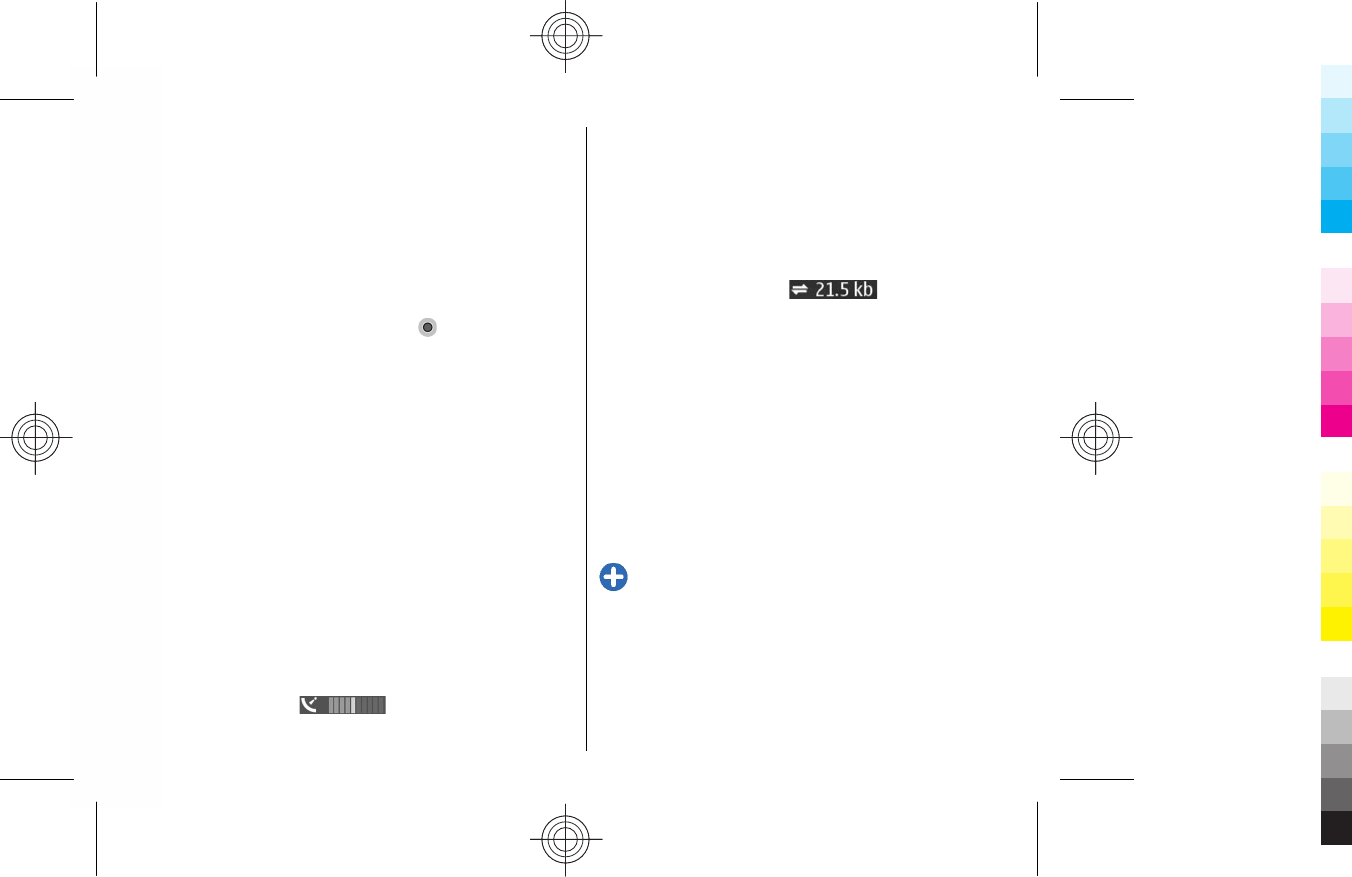
Move on a map
The map coverage varies by country and region.
When you open Maps, the capital of the country you are in
or the location that was saved from your last session is
shown. The map of the location is also downloaded, if
needed.
To zoom in to your GPS position or your last known
location, press the function key and 0.
When the GPS connection is active, shows your current
location on the map.
To move on the map, scroll up, down, left, or right with
the scroll key. The map is oriented towards north by
default.
To zoom in and out on the map, press the function key and
*, or the function key and #.
When you browse the map on the display, a new map is
automatically downloaded if you scroll to an area which
is not covered by maps already downloaded. These maps
are free of charge, but downloading may involve the
transmission of large amounts of data through your
service provider's network. For more information on data
transmission charges, contact your service provider. The
maps are automatically saved in the device memory or on
a compatible memory card (if inserted).
Display indicators
The GPS indicator on the bottom right corner
of the display shows the availability and strength of the
satellite signal. One bar is one satellite. When the device
tries to find a satellite, the bar is yellow. When the device
receives enough data from the satellite to establish a GPS
connection, the bar turns green. The more green bars, the
stronger the GPS connection.
Initially, your device must receive signals from at least four
satellites to calculate the coordinates of your location.
After the initial calculation, signals from three satellites
may be enough.
The data transfer indicator shows the
internet connection used and the amount of data
transferred since the application started.
Find locations
To find a location in the city or area displayed on the map,
enter the full or partial address of the location in the search
field, and press the scroll key. To find a location in another
city, enter the city and the full or partial address, such as
London Oxford Street, and press the scroll key.
To find a specific address, or an address in another country,
select Options > Search > Addresses. Country/Region
* and City or post code are mandatory.
Tip: To search for locations in another country
using the search field, enter also the name of the
country in the search field: Rome Italy.
To import a location address from the Contacts
application, select Options > Search > Addresses >
Options > Select from Contacts.
The search results are grouped by categories. To limit the
search to one category, select Options > Search.
34
Maps
Cyan
Cyan
Magenta
Magenta
Yellow
Yellow
Black
Black
Cyan
Cyan
Magenta
Magenta
Yellow
Yellow
Black
Black

If you search for locations without an internet connection,
the search results are limited to a radius of 50 km (31
miles).
Plan a route
To plan a route, select your start point on the map or
search for a location, press the scroll key, and select Add
to route.
To define the destination and add more locations for your
route, select Options > Add route point, and search for
the location.
To switch between walking or driving mode, select
Options > Settings > Transport mode
To show the route on the map, select Options > Show
route.
To navigate to the destination by car or on foot, if you have
purchased a licence for these extra services, select
Options > Start driving or Start walking .
To save the route, select Options > Save route.
35
Maps
Cyan
Cyan
Magenta
Magenta
Yellow
Yellow
Black
Black
Cyan
Cyan
Magenta
Magenta
Yellow
Yellow
Black
Black

Media
Your device contains a variety of media applications for
both business and leisure time use.
For more information, see the extended user guide on the
web.
Camera
Select Menu > Media > Camera.
Capture an image
Your device supports an image capture resolution of up to
1600x1200 pixels. The image resolution in this guide may
appear different.
To capture an image, use the display as a viewfinder, aim
at your subject, and press the scroll key. The device saves
the image in Gallery, or in the folder you have defined.
Tip: To zoom in or out before capturing an image,
scroll up or down.
If you do not want to keep the captured image, select
Options > Delete. Select Back to return to the viewfinder
to capture another image. Select Options > Go to
Gallery to view the image in Gallery.
Select Options > Flash to always use flash, never use it,
or use it automatically according to surrounding light
conditions.
If the light is dim, select Options > Night mode > On
before capturing an image.
To adjust the image, select Options > Adjust > White
balance or Colour tone.
To capture images in a sequence, select Options >
Sequence mode. The camera captures six images in a
row.
To capture timed images, select Options > Self-timer,
and the desired time-out. The camera captures an image
after the time-out has passed.
Tip: To access the various camera modes quickly,
select Options > Show toolbar.
To view the captured images, select Menu > Media >
Gallery > Images.
Record a video clip
1. To start recording a video clip, press the scroll key. The
remaining recording time is shown at the top of the
display.
2. To pause the recording, select Pause; to resume the
recording, select Continue.
36
Media
Cyan
Cyan
Magenta
Magenta
Yellow
Yellow
Black
Black
Cyan
Cyan
Magenta
Magenta
Yellow
Yellow
Black
Black

3. To stop the recording, select Stop. The device saves the
clip in Gallery, or in the folder you have defined.
4. If you do not want to keep the recorded video clip,
select Options > Delete. Select Back to return to the
viewfinder to record another video clip. Select
Options > Play to view the video clip in the RealPlayer
application.
Music player
Warning: Listen to music at a moderate level.
Continuous exposure to high volume may damage your
hearing. Do not hold the device near your ear when the
loudspeaker is in use, because the volume may be
extremely loud.
Select Menu > Media > Music player.
Music player supports files formats such as AAC, AAC+, eAAC
+, MP3, and WMA. Music player does not necessarily
support all features of a file format or all the variations of
file formats.
You can also use Music player to listen to podcast episodes.
Podcasting is a method for delivering audio or video
content over the internet using either RSS or Atom
technologies for playback on mobile devices and PCs.
You can transfer music from other compatible devices to
your device. See "Transfer music from PC", p. 38.
Play a song or a podcast
episode
To add all available songs and podcasts to the music
library, select Options > Refresh.
To play a song or a podcast episode, select Music or
Podcasts and the desired category, then scroll to the song
or podcast episode and press the scroll key.
To adjust the volume, scroll up or down.
To pause playback, press the scroll key; to resume, press
the scroll key again. To stop playback, scroll down.
To fast-forward or rewind, press and hold the scroll key to
the right or left.
To go to the next item, scroll right. To return to the
beginning of the item, scroll left. To skip to the previous
item, scroll left again within 2 seconds after a song or
podcast has started.
To return to the home screen and leave the player playing
in the background, press the end key.
Nokia Music Store
Select Menu > Media > Music store.
In the Nokia Music Store (network service) you can search,
browse, and purchase music to download to your device.
To purchase music, you need to register for the service.
To check the Nokia Music Store availability in your country,
visit www.nokia.com/music.
To find more music in the different categories, select
Options > Find in Music store.37
Media
Cyan
Cyan
Magenta
Magenta
Yellow
Yellow
Black
Black
Cyan
Cyan
Magenta
Magenta
Yellow
Yellow
Black
Black

To select the access point to use with the Music Store,
select Default acc. pt..
Transfer music from PC
To transfer music from your PC, connect your device to the
PC with a compatible USB data cable or Bluetooth
connectivity. If you are using the USB cable, select Mass
storage as the connection mode. Make sure that a
compatible memory card is inserted in the device.
If you selectMedia transfer as the connection mode, you
can use Windows Media Player to synchronise music
between your device and PC.
Share online
Select Menu > Media > Share online.
You can share images and video clips in compatible online
albums, blogs, or in other compatible online sharing
services on the web. You can upload content, save
unfinished posts as drafts and continue later, and view the
content of the albums. The supported content types may
vary depending on the service provider.
To share files online, you must have an account with an
online image sharing service. You can usually subscribe to
such a service on the web page of your service provider.
Contact your service provider for more information.
Share images online
To upload a file from Gallery to the online service, select
Menu > Gallery, select the desired file and Options >
Send > Post to web.
Recorder
Select Menu > Media > Recorder.
With Recorder, you can record up to 60 minutes of a voice
memo, save the voice recording as a sound clip, and play
the sound clip. Recorder supports the AMR file format.
Gallery
Select Menu > Media > Gallery.
Use Gallery to access and use different types of media,
including images, videos, music, and sounds. All viewed
images and videos, and all received music and sounds are
automatically saved to Gallery. Sound clips are opened in
the Music player, and video clips and streaming links in the
RealPlayer application. Images are opened in the image
viewer.
View images
To open an image for viewing, select Options > Open.
To open the next or previous image for viewing, scroll right
or left.
38
Media
Cyan
Cyan
Magenta
Magenta
Yellow
Yellow
Black
Black
Cyan
Cyan
Magenta
Magenta
Yellow
Yellow
Black
Black
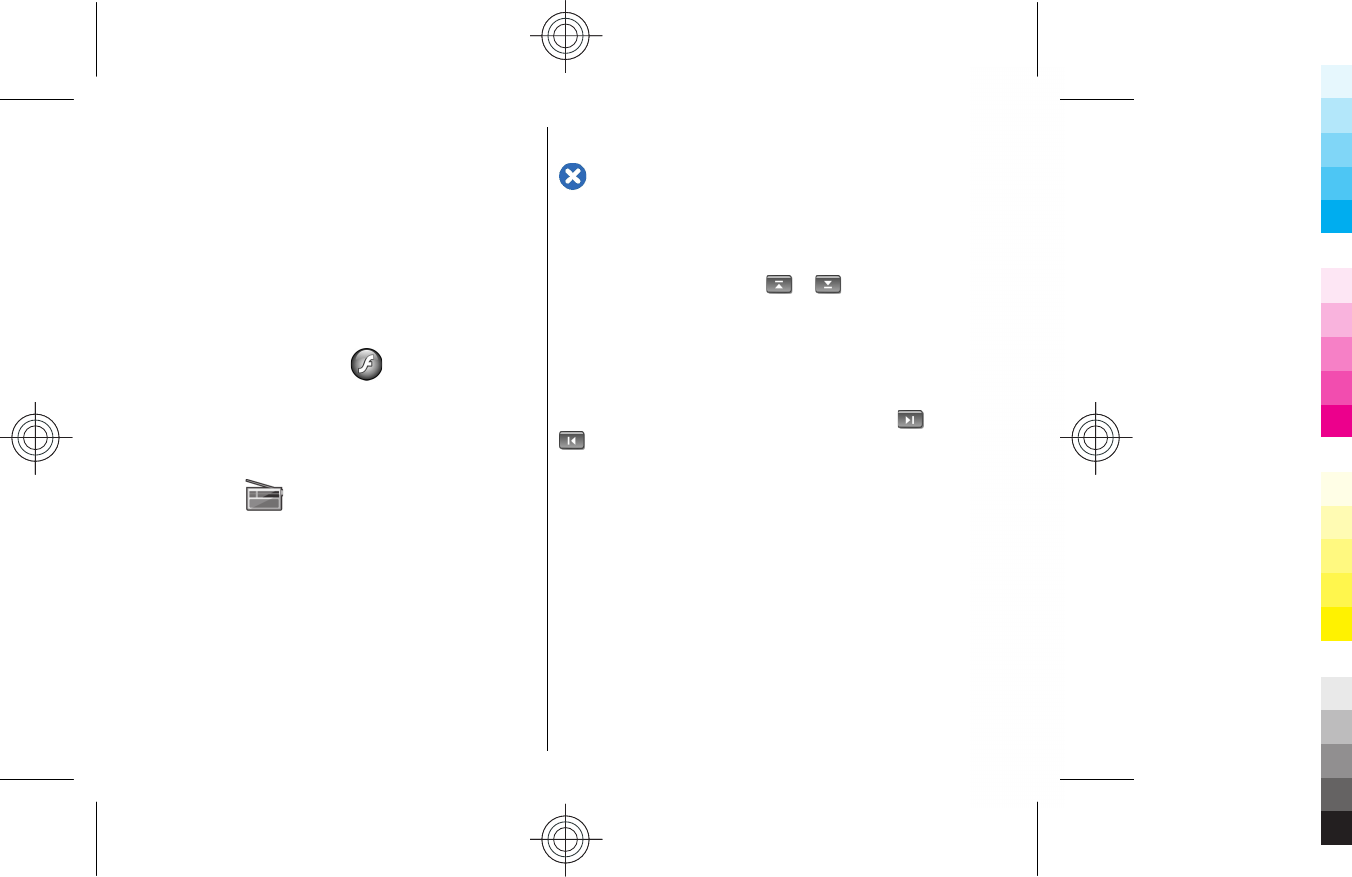
To enlarge the image on the display, select Options >
Zoom in. To reduce the image on the display, select Zoom
out.
To view the image in full screen size, select Options >
Full screen. To return to normal view, select Options >
Normal screen.
To rotate the image, select Options > Rotate. Select
Right to rotate the image clockwise by 90 degrees, or
select Left to rotate the image counterclockwise by 90
degrees.
Flash player
Select Menu > Media > Flash Player.
With Flash player, you can view, play, and interact with
flash files made for mobile devices.
Radio
Select Menu > Media > Radio.
The quality of the radio broadcast depends on the
coverage of the radio station in that particular area.
The FM radio depends on an antenna other than the
wireless device antenna. Attach a compatible headset or
enhancement to the device for the FM radio to function
properly.
Listen to the radio
Warning: Listen to music at a moderate level.
Continuous exposure to high volume may damage your
hearing. Do not hold the device near your ear when the
loudspeaker is in use, because the volume may be
extremely loud.
To search for a station, select or . To set the
frequency manually, select Options > Manual tuning.
To view available stations based on location, select
Options > Station directory (network service).
To save the current station to your station list, select
Options > Save station.
To select a previously saved radio station, select or
.
To adjust the volume, scroll left or right.
To switch from headset use to listening to the radio
through the loudspeaker, select Options > Activate
loudspeaker.
To return to the home screen and leave the FM radio
playing in the background, select Options > Play in
background.
Internet radio
Select Menu > Media > Internet radio.
39
Media
Cyan
Cyan
Magenta
Magenta
Yellow
Yellow
Black
Black
Cyan
Cyan
Magenta
Magenta
Yellow
Yellow
Black
Black

Listen to internet radio
stations
Warning: Listen to music at a moderate level.
Continuous exposure to high volume may damage your
hearing. Do not hold the device near your ear when the
loudspeaker is in use, because the volume may be
extremely loud.
To listen to a radio station on the internet, select a station
from the station directory, search stations by their name
from the Nokia Internet Radio service, or select Options >
Add station manually. When you have found the correct
station, select Listen.
To stop the playback, press the scroll key. To resume the
playback, press the scroll key again.
To adjust the volume, keep the function key pressed down
and scroll up or down.
To view station information, select Options > Station
information (not available if you have saved the station
manually).
If you are listening to a station saved in your favourites,
scroll left or right to listen to the previous or next saved
station.
Tip: You can browse for station links with the Web
application. Compatible links are automatically
opened in the Internet radio application.
Search for stations
To search for radio stations in the Nokia Internet Radio
service by their name, select Search. Enter a station name
or the first letters of it in the search field, and select
Search.
To listen to the station, select Listen.
To save the station to your favourites, select Options >
Add to Favourites.
To make another search, select Options > Search
again.
Save stations
To view and listen to your favourite stations, select
Favourites.
To add a station manually to favourites, select Options >
Add station manually. Enter the web address of the
station and a name that you want to appear in the
favourites list.
To add the currently playing station to favourites, select
Options > Add to Favourites.
To view station information, to move a station up or down
in the list, or to delete a station from the favourites, select
Options > Station and the desired option.
To view only stations beginning with particular letters or
numbers, start entering the characters. Matching stations
are displayed.
40
Media
Cyan
Cyan
Magenta
Magenta
Yellow
Yellow
Black
Black
Cyan
Cyan
Magenta
Magenta
Yellow
Yellow
Black
Black

Internet radio settings
To select the default access point to connect to the
network, select Options > Settings > Default access
point. Select Always ask if you want the device to ask for
the access point every time you open the application.
To change the connection speed for GPRS packet data
connections, select Options > Settings > GPRS
connection bitrate.
To change the connection speed for 3G packet data
connections, select Options > Settings > 3G
connection bitrate.
To change the connection speed for WLAN connections,
select Options > Settings > Wi-Fi connection
bitrate.
The quality of the radio broadcast depends on the selected
connection speed. The higher the speed, the better the
quality. To avoid buffering, use the highest quality only
with high speed connections.
41
Media
Cyan
Cyan
Magenta
Magenta
Yellow
Yellow
Black
Black
Cyan
Cyan
Magenta
Magenta
Yellow
Yellow
Black
Black

Personalisation
You can personalise your device by adjusting the various
tones, background images, and screen savers, for
example.
Profiles
Select Menu > Tools > Profiles.
You can adjust and customise the ringing tones, alert
tones, and other device tones for different events,
environments, or caller groups. The profile currently in use
is shown at the top of the display on the home screen.
However, if the active profile is General, only today's date
is shown.
To create a new profile, select Options > Create new,
and define the settings.
To customise a profile, select a profile and Options >
Personalise.
To change a profile, select a profile and Options >
Activate.The Offline profile prevents your device from
accidentally switching on, sending or receiving messages,
or using wireless LAN, Bluetooth, or FM radio; it also closes
any internet connection that may be in operation when
the profile is selected. The Offline profile does not prevent
you from establishing a wireless LAN or Bluetooth
connection at a later time, or from restarting the FM radio,
so comply with any applicable safety requirements when
establishing and using these features.
To delete a profile that you created, select Options >
Delete profile. You cannot delete the predefined profiles.
Select ringing tones
To set a ringing tone for a profile, select Options >
Personalise > Ringing tone. Select a ringing tone from
the list, or select Download sounds to open a bookmark
folder containing a list of bookmarks for downloading
tones using the browser. Any downloaded tones are saved
to Gallery.
To play the ringing tone for a selected contact group only,
select Options > Personalise > Alert for, and select the
desired group. Phone calls coming from outside that
group have a silent alert.
To change the message tone, select Options >
Personalise > Message alert tone.
42
Personalisation
Cyan
Cyan
Magenta
Magenta
Yellow
Yellow
Black
Black
Cyan
Cyan
Magenta
Magenta
Yellow
Yellow
Black
Black

Personalise the home
screen
Select Menu > Tools > Modes.
To change the name of the current home screen, select
Mode name.
To select which applications and notifications you want to
see on the home screen, select Home screen
applications.
To change the theme of the home screen currently in use,
select Theme.
To change the background image of the home screen
currently in use, select Wallpaper.
To change from one home screen to another, select
Switch mode.
Change the display
theme
Select Menu > Tools > Themes.
To change the theme used in all applications, select the
General folder.
To change the theme used in the main menu, select the
Menu view folder.
To change the theme for a particular application, select
the application-specific folder.
To change the background image of the home screen,
select the Wallpaper folder.
To select an animation for the screen saver, select the
Power saver folder.
43
Personalisation
Cyan
Cyan
Magenta
Magenta
Yellow
Yellow
Black
Black
Cyan
Cyan
Magenta
Magenta
Yellow
Yellow
Black
Black

Nokia Office Tools
Nokia Office Tools support mobile business and enable
effective communication with work teams.
Active notes
Select Menu > Office > Active notes.
Active notes allows you to create, edit, and view different
kinds of notes, for example, meeting memos, hobby notes,
or shopping lists. You can insert images, videos, and sound
in the notes. You can link notes to other applications, such
as Contacts, and send notes to others.
To create a note, start writing.
To edit a note, scroll to it, and press the scroll key.
To insert images, sound clips, video, business cards, web
bookmarks, and files, select Options > Insert object.
To add new items to the note, select Options > Insert
new. You can record sound and video clips, and capture
images.
To add boldface, italics, or underlining to your text or
change the font colour, press and hold the shift key and
use the scroll key to select the text. Then select Options >
Text.
To send the note, select Options > Send.
To link a note to a contact, select Options > Link note to
call > Add contacts. You can see the note on the display
of your device when making a call to or receiving a call
from the contact.
Calculator
Select Menu > Office > Calculator.
This calculator has limited accuracy and is designed for
simple calculations.
To make a calculation, enter the first number of the
calculation. Select a function such as add or subtract from
the function map. Enter the second number of the
calculation, and select =. The calculator performs
operations in the order they are entered. The result of the
calculation remains in the editor field and can be used as
the first number of a new calculation.
The device saves the result of the last calculation in its
memory. Exiting the Calculator application or switching off
the device does not clear the memory. To recall the last
saved result the next time you open the Calculator
application, select Options > Last result.
To save the numbers or results of a calculation, select
Options > Memory > Save.
44
Nokia Office Tools
Cyan
Cyan
Magenta
Magenta
Yellow
Yellow
Black
Black
Cyan
Cyan
Magenta
Magenta
Yellow
Yellow
Black
Black

To retrieve the results of a calculation from the memory
and use them in a calculation, select Options >
Memory > Recall.
File manager
Select Menu > Office > File mgr..
With File manager, you can manage the contents and
properties of files and folders on your device memory and
memory card. You can open, create, move, copy, rename,
send, and search for files and folders. Copyright protection
may prevent sending some files.
Open the device tab or the memory card tab.
To select multiple files, scroll to each file, and select
Options > Mark/Unmark > Mark.
To send the selected files, select Options > Send.
To move or copy files or folders to another folder, select
Options > Move to folder or Copy to folder. Default
folders such as Sound clips in Gallery cannot be moved.
To search for files, select Options > Find. Enter the search
text, and press the scroll key. The folders and files whose
names contain the search text are displayed.
To view information about the selected file, select
Options > View details. To view additional information
about the file online, select Options > Additional
details.
Quickoffice
Select Menu > Office > Quickoffice.
Quickoffice consists of Quickword for Microsoft Word,
Quicksheet for Microsoft Excel, Quickpoint for Microsoft
PowerPoint, and Quickmanager for purchasing software.
You can view Microsoft Office 2000, XP, and 2003
documents (*.doc, *.xls, and *.ppt) with Quickoffice. If you
have the editor version of Quickoffice, you can also edit
files.
All file formats or features are not supported.
Work with files
To open a file, scroll to it, and press the scroll key.
To sort files according to the type, select Options > Sort
by.
To view the details of a file, select Options > Details. The
details include the name, size and location of the file, and
the time and date when the file was last modified.
To send files to a compatible device, select Options >
Send and the sending method.
Converter
Select Menu > Office > Converter.
The converter has limited accuracy, and rounding errors
may occur.
Convert measurements
1. Scroll to the Type field, and select Options >
Conversion type to open a list of measures. Select the
measure to use, and select OK.45
Nokia Office Tools
Cyan
Cyan
Magenta
Magenta
Yellow
Yellow
Black
Black
Cyan
Cyan
Magenta
Magenta
Yellow
Yellow
Black
Black

2. Scroll to the first Unit field, and select Options >
Select unit. Select the unit from which to convert, and
select OK. Scroll to the next Unit field, and select the
unit to which to convert.
3. Scroll to the first Amount field, and enter the value to
convert. The other Amount field changes
automatically to show the converted value.
Set base currency and
exchange rate
When you change base currency, you must enter new
exchange rates because all previously set exchange rates
are cleared.
Before you can make currency conversions, you must
choose a base currency and add exchange rates. The rate
of the base currency is always 1. The base currency
determines the conversion rates of the other currencies.
1. To set the rate of exchange for the unit of currency,
scroll to the Type field, and select Options > Currency
rates.
2. Scroll to the currency type and enter the exchange rate
you would like to set per single unit of currency.
3. To change the base currency, scroll to the currency, and
select Options > Set as base currency.
4. Select Done > Yes to save the changes.
After you have inserted all the necessary exchange rates,
you can make currency conversions.
Zip manager
Select Menu > Office > Zip.
With Zip manager, you can create new archive files to store
compressed ZIP formatted files; add single or multiple
compressed files or directories to an archive; set, clear, or
change the archive password for protected archives; and
change settings, such as compression level, and file name
encoding.
You can store the archive files on the device memory or on
a memory card.
PDF reader
Select Menu > Office > Adobe PDF.
With PDF reader you can read PDF documents on the
display of your device; search for text in the documents;
modify settings, such as zoom level and page views; and
send PDF files using e-mail.
Printing
You can print documents, such as files, messages, or web
pages, from the device, preview a print job, define page
layout options, select a printer, or print to a file. You may
not be able to print all types of documents.
To configure a printer for your device, select Menu >
Office > Printers > Options > Add. To set the printer
as the default printer, select Options > Printing
options > Printers, scroll to the printer and select
Options > Set as default.
46
Nokia Office Tools
Cyan
Cyan
Magenta
Magenta
Yellow
Yellow
Black
Black
Cyan
Cyan
Magenta
Magenta
Yellow
Yellow
Black
Black

Before you print, make sure your device is properly
connected to the printer.
To print a document, select Options > Printing
options > Print.
To print to a file, select Options > Printing options >
Print > Print to file, and determine the location for the
file.
To change the printing options, select Options >
Printing options. You can select the printer you want to
use, the number of copies and the range of pages you want
to print.
To change the page layout before printing, select
Options > Printing options > Page setup. You can
change the paper size and orientation, define the margins,
and insert a header or a footer. The maximum length of
the header and footer is 128 characters.
To preview a file or message before you print, select
Options > Printing options > Preview.
Clock
Select Menu > Office > Clock.
In Clock, you can view your local time and time zone
information, set and edit alarms, or modify date and time
settings.
Alarm clock
Open the alarm clock tab.
To set an alarm, select Options > New alarm. When an
alarm is active, is displayed.
To switch off the alarm, select Stop, or to stop the alarm
for 5 minutes, select Snooze. If the alarm time is reached
while the device is switched off, the device switches itself
on and starts sounding the alarm tone. If you select
Stop, the device asks whether you want to activate the
device for calls. Select No to switch off the device or Yes
to make and receive calls. Do not select Yes when wireless
phone use may cause interference or danger.
To change the alarm time, select Options > Reset
alarm.
To remove the alarm, select Options > Remove alarm.
Clock settings
Select Options > Settings.
To change the time or date, select Time or Date.
To change the clock shown on the home screen, select
Clock type > Analogue or Digital.
To allow the mobile phone network to update the time,
date, and time zone information to your device (network
service), select Network operator time > Auto-
update.
To change the alarm tone, select Clock alarm tone.
47
Nokia Office Tools
Cyan
Cyan
Magenta
Magenta
Yellow
Yellow
Black
Black
Cyan
Cyan
Magenta
Magenta
Yellow
Yellow
Black
Black

Connectivity
Your device offers several options to connect to the
internet, a corporate intranet, or to another device or
computer.
Data cable
To avoid damaging the memory card, do not remove the
data cable in the middle of a data transfer.
Transfer data between your device and a PC
1. Insert a memory card to your device and connect the
device to a compatible PC with the USB data cable.
2. When the device asks which mode is used, select Mass
storage. In this mode, you can see your device as a
removable hard drive in your computer.
3. End the connection from the computer (for example,
from an Unplug or Eject Hardware wizard in Windows)
to avoid damaging the memory card.
To use Nokia PC Suite with your device, install Nokia PC
Suite on your PC, connect the data cable, and select PC
Suite.
To use your device to connect your PC to the web, connect
the data cable, and select Connect PC to web.
To synchronise the music in your device with Nokia Music
Player, install the Nokia Music Player software on your PC,
connect the data cable, and select Media transfer.
To change the USB mode you normally use with the data
cable, select Menu > Connectivity > USB > USB
connection mode and the desired option.
To set the device to ask for the mode each time you
connect the USB data cable to the device, select Menu >
Connectivity > USB > Ask on connection > Yes.
Bluetooth
Select Menu > Connectivity > Bluetooth.
About Bluetooth
Bluetooth technology enables wireless connections
between electronic devices within a range of 10 metres
(33 feet). A Bluetooth connection can be used to send
images, videos, text, business cards, calendar notes, or to
connect wirelessly to devices that use Bluetooth
technology.
Since devices using Bluetooth technology communicate
using radio waves, your device and the other devices do
not need to be in direct line-of-sight. The two devices only
48
Connectivity
Cyan
Cyan
Magenta
Magenta
Yellow
Yellow
Black
Black
Cyan
Cyan
Magenta
Magenta
Yellow
Yellow
Black
Black

need to be within a maximum of 10 metres of each other,
although the connection can be subject to interference
from obstructions such as walls or other electronic
devices.
Several Bluetooth connections can be active at a time. For
example, if your device is connected to a headset, you can
also transfer files to another compatible device at the
same time.
Features using Bluetooth technology increase the demand
on battery power and reduce the battery life.
Send and receive data with
Bluetooth
1. When you activate Bluetooth for the first time, you are
asked to give a name to your device. Give your device
a unique name to make it easy to recognise if there are
several Bluetooth devices nearby.
2. Select Bluetooth > On.
3. Select My phone's visibility > Shown to all or
Define period. If you select Define period, you need
to define the time during which your device is visible
to others. Your device and the name you entered can
now be seen by other users with devices using
Bluetooth technology.
4. Open the application where the item you want to send
is stored.
5. Select the item and Options > Send > Via
Bluetooth. The device searches for other devices using
Bluetooth technology within range and lists them.
Tip: If you have sent data using Bluetooth
before, a list of the previous search results is
displayed. To search for more Bluetooth devices,
select More devices.
6. Select the device with which you want to connect. If
the other device requires pairing before data can be
transmitted, you are asked to enter a passcode.
When the connection has been established, Sending
data is shown.
The Sent folder in the Messaging application does not
store messages sent using Bluetooth connectivity.
To receive data using Bluetooth, select Bluetooth > On
and My phone's visibility > Shown to all to receive data
from a non-paired device or Hidden to receive data from
a paired device only. When you receive data through
Bluetooth, depending on the settings of an active profile,
a tone sounds, and you are asked if you want to accept the
message in which the data is included. If you accept, the
message is placed in the Inbox folder in the Messaging
application.
Tip: You can access the files in the device or on the
memory card using a compatible accessory that
supports the File Transfer Profile Client service (for
example, a laptop computer).
A Bluetooth connection is disconnected automatically
after sending or receiving data. Only Nokia PC Suite and
some enhancements such as headsets may maintain a
connection even if not actively used.
Pair devices
Open the paired devices tab. 49
Connectivity
Cyan
Cyan
Magenta
Magenta
Yellow
Yellow
Black
Black
Cyan
Cyan
Magenta
Magenta
Yellow
Yellow
Black
Black

Before pairing, decide on your own passcode (1-16 digits),
and agree with the user of the other device to use the same
code. Devices that do not have a user interface have a fixed
passcode. You need the passcode only when you connect
the devices for the first time. After pairing, it is possible to
authorise the connection. Pairing and authorising the
connection makes connecting quicker and easier, as you
do not have to accept the connection between paired
devices every time you establish a connection.
The passcode for remote SIM access must have 16 digits.
1. Select Options > New paired device. The device
starts to search for Bluetooth devices within range. If
you have sent data using Bluetooth before, a list of the
previous search results is displayed. To search for more
Bluetooth devices, select More devices.
2. Select the device with which you want to pair, and
enter the passcode. The same passcode must be
entered to the other device as well.
3. Select Yes to make the connection between your
device and the other device automatic, or No to
confirm the connection manually every time a
connection attempt is made. After pairing, the device
is saved to the paired devices page.
To give a nickname to the paired device, select Options >
Assign short name. The nickname is only displayed in
your device.
To delete a pairing, select the device whose pairing you
want to delete and Options > Delete. To delete all
pairings, select Options > Delete all. If you are currently
connected to a device and cancel the pairing with that
device, pairing is removed immediately, and the
connection is ended.
To allow a paired device to connect automatically to your
device, select Set as authorised. Connections between
your device and the other device can be made without
your knowledge. No separate acceptance or authorisation
is needed. Use this status for your own devices, such as
your compatible headset or computer, or devices that
belong to someone you trust. If you want to accept
connection requests from the other device separately
every time, select Set as unauthorised.
To use a Bluetooth audio enhancement such as a
Bluetooth handsfree or headset, you need to pair your
device with the enhancement. See the enhancement user
guide for the passcode and further instructions. To
connect to the audio enhancement, switch on the
enhancement. Some audio enhancements connect
automatically to your device. Otherwise open the paired
devices tab, scroll to the enhancement, and select
Options > Connect to audio device.
Security tips
When you are not using Bluetooth connectivity, select
Bluetooth > Off or My phone's visibility > Hidden.
Do not pair with an unknown device.
Wireless LAN
Some places, like France, have restrictions on the use of
wireless LAN. Check with your local authorities for more
information.
Your device can detect and connect to a wireless local area
network (WLAN). To use WLAN, a network must be
50
Connectivity
Cyan
Cyan
Magenta
Magenta
Yellow
Yellow
Black
Black
Cyan
Cyan
Magenta
Magenta
Yellow
Yellow
Black
Black
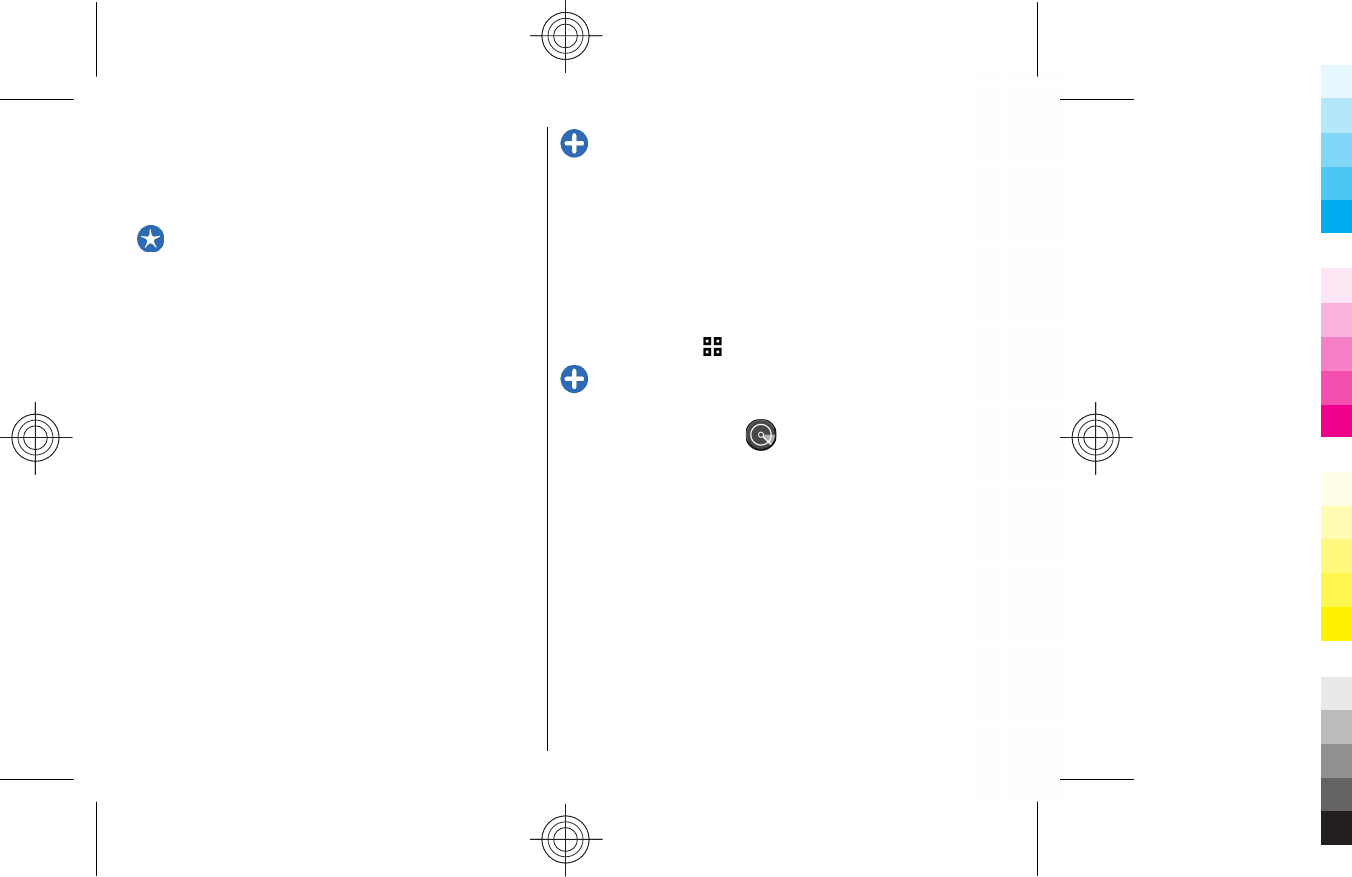
available in the location and your device must be
connected to it.
WLAN connections
Important: Always enable one of the available
encryption methods to increase the security of your
wireless LAN connection. Using encryption reduces the risk
of unauthorised access to your data.
To use WLAN, you must create an internet access point in
a WLAN. Use the access point for applications that need to
connect to the internet. A WLAN connection is established
when you create a data connection using a WLAN access
point. The active WLAN connection is ended when you end
the data connection. You can also end the connection
manually. See "Connection manager", p. 52.
You can use WLAN during a voice call or when packet data
is active. You can only be connected to one WLAN access
point device at a time, but several applications can use the
same internet access point.
When the device is in the Offline profile, you can still use
WLAN, if available. Remember to comply with any
applicable safety requirements when establishing and
using a WLAN connection.
If you move the device to another location within the
WLAN and out of range of a WLAN access point, the
roaming functionality can automatically connect your
device to another access point that belongs to the same
WLAN. As long as you remain within range of access points
that belong to the same network, your device can stay
connected to the network.
Tip: To check the unique media access control (MAC)
address that identifies your device, for example to
configure the MAC address of your device to a WLAN
router, enter *#62209526# on the device keypad.
The MAC address is shown on the device display.
See WLAN availability
To have your device show WLAN availability, select
Menu > Tools > Settings > Connection > Wireless
LAN > Show WLAN availability.
If WLAN is available, is shown on the display.
Tip: You can also scan for networks in range.
WLAN wizard
Select Menu > Connectivity > WLAN wiz..
The WLAN wizard helps you find and connect to a wireless
LAN. When you open the application, your device starts to
scan for available WLANs and lists them.
To update the list of available WLANs, select Options >
Refresh.
To mark up WLANs in the list of found networks, select
Filter WLAN networks. The selected networks are filtered
out the next time the application searches for wireless
LANs.
To start or continue browsing the web using the access
point of the WLAN, scroll to the desired network, and select
Options > Start web browsing or Cont.web
browsing.51
Connectivity
Cyan
Cyan
Magenta
Magenta
Yellow
Yellow
Black
Black
Cyan
Cyan
Magenta
Magenta
Yellow
Yellow
Black
Black
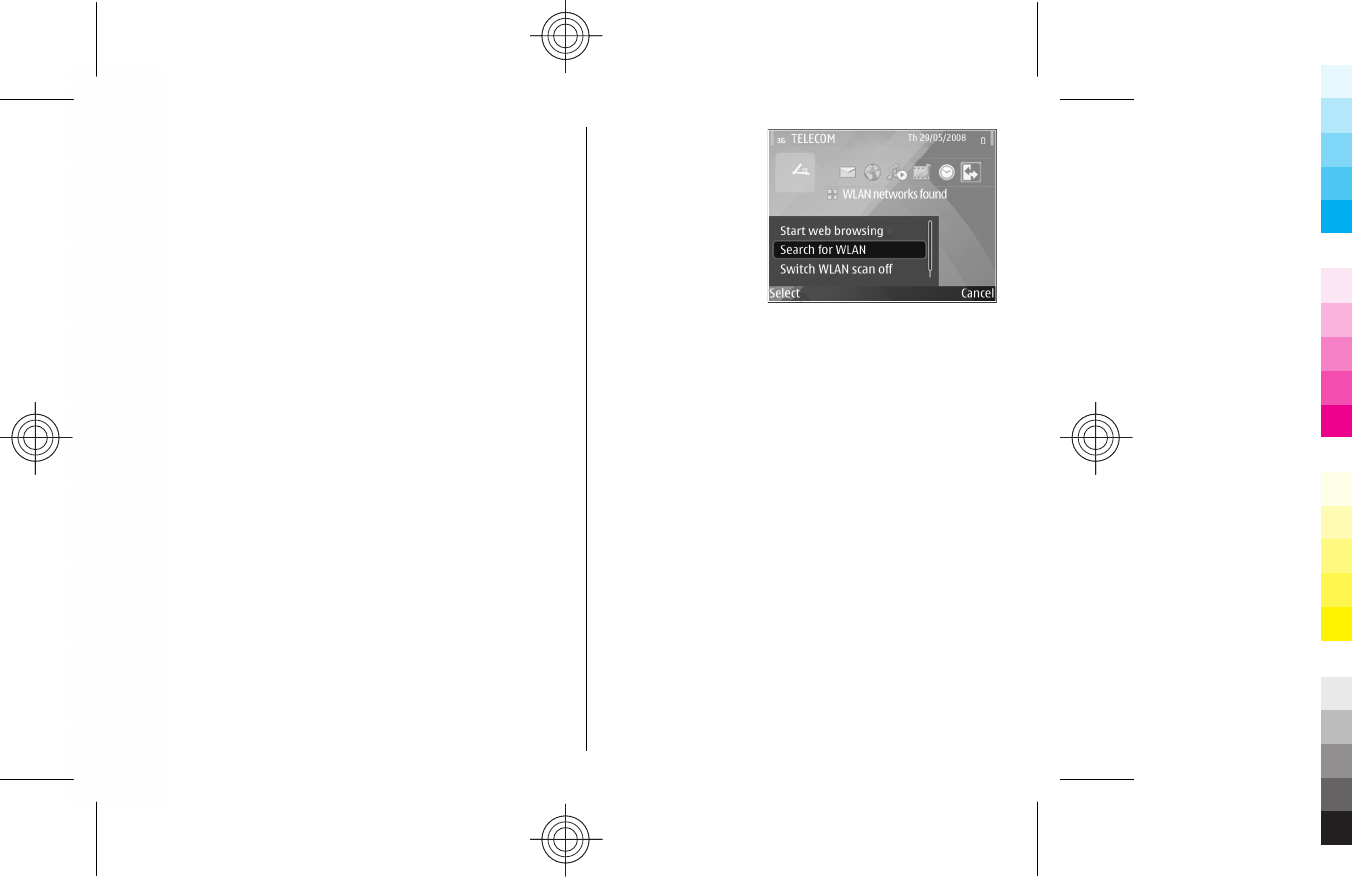
To disconnect the active connection to the WLAN, select
Options > Disconnect WLAN.
To view the details of the WLAN, select Options >
Details.
To save the access point of the WLAN, select Options >
Define access point.
Always enable one of the available encryption methods to
increase the security of your WLAN connection. Using
encryption reduces the risk of unauthorised access to your
data.
Use the wizard on the home screen
On the home screen, the WLAN wizard shows the status of
your WLAN connections and network searches. To view the
available options, scroll to the row showing the status, and
press the scroll key. Depending on the status, you can start
the web browser using a WLAN connection, connect to
your net call service, disconnect from a WLAN, search for
WLANs, or set the network scanning on or off.
If WLAN scanning is off and you are not connected to any
WLAN, WLAN scanning off is displayed on the home
screen. To set scanning on and search for available WLANs,
scroll to the row showing the status, and press the scroll
key.
To start a search for
available WLANs, scroll
to the row showing the
status, press the scroll
key, and select Search
for WLAN. To set WLAN
scanning off, scroll to
the row showing the
status, press the scroll
key, and select Switch
WLAN scan off.
When Start web browsing or Use for is selected, the
WLAN wizard automatically creates an access point for the
selected WLAN. The access point can also be used with
other applications requiring WLAN connection.
If you select a secured WLAN, you are asked to enter the
relevant passcodes. To connect to a hidden network, you
must enter the correct service set identifier (SSID).
To use the found WLAN for a net call connection, scroll to
the row showing the status, and press the scroll key. Select
Use for, the desired net call service, and the WLAN to be
used.
Connection manager
Select Menu > Connectivity > Conn. mgr..
52
Connectivity
Cyan
Cyan
Magenta
Magenta
Yellow
Yellow
Black
Black
Cyan
Cyan
Magenta
Magenta
Yellow
Yellow
Black
Black

View and end active
connections
To see the open data connections, select Active data
connections.
To view detailed information about network connections,
select a connection from the list and Options > Details.
The type of information shown depends on the connection
type.
To end the selected network connection, select Options >
Disconnect.
To end all active network connections simultaneously,
select Options > Disconnect all.
Search for WLAN
To search for WLANs available within range, select
Available WLAN networks. The available WLANs are
listed with their network mode (infrastructure or ad-hoc),
signal strength, and network encryption indicators, and
whether your device has an active connection with the
network.
To view the details of a network, scroll to it, and press the
scroll key.
To create an internet access point for a network, select
Options > Define access point.
53
Connectivity
Cyan
Cyan
Magenta
Magenta
Yellow
Yellow
Black
Black
Cyan
Cyan
Magenta
Magenta
Yellow
Yellow
Black
Black

Security and data management
Manage the data and software on your device, and take
care of the security of the device and its contents.
Important: Your device can only support one
antivirus application. Having more than one application
with antivirus functionality could affect performance and
operation or cause the device to stop functioning.
Lock the device
Important: If the device has been locked, enter the
lock code to activate the phone function. When the device
is locked, calls may be possible to the official emergency
number. Making an emergency call in the offline profile or
when the device is locked requires that the device
recognise the number to be an official emergency number.
It is advisable to change the profile or unlock the device
by entering the lock code before you make the emergency
call.
To prevent access to the contents of your device, lock the
device when in home screen. Press the power key, select
Lock phone, and enter your lock code. The default lock
code is 12345. To unlock, press the left selection key, enter
your lock code, and press the scroll key.
To change the lock code, select Menu > Tools >
Settings > General > Security > Phone and SIM
card > Lock code. Enter the old code and then the new
code twice. The new code can be 4-255 characters long.
Both alphabets and digits can be used, and both uppercase
and lowercase alphabets are possible.
You can also lock the device remotely by sending a text
message to the device. To enable remote locking and to
define the text for the message, select Menu > Tools >
Settings > General > Security > Phone and SIM
card > Allow remote lock > Yes. Enter the remote lock
message and confirm the message. The message must be
at least 5 characters long.
Memory
There are two types of memory into which you can save
data or install applications: device memory and memory
card.
Free memory
To see how much memory is currently in use, how much
free memory remains, and how much memory is
consumed by each data type, select Menu > Options >
Memory details > Phone memory or Memory card.
54
Security and data management
Cyan
Cyan
Magenta
Magenta
Yellow
Yellow
Black
Black
Cyan
Cyan
Magenta
Magenta
Yellow
Yellow
Black
Black

Tip: To ensure that you have adequate memory,
transfer data regularly to a memory card or
computer, or use File manager to delete files you no
longer need.
After you install applications to a compatible memory
card, installation files (.sis, .sisx) remain in the device
memory. The files may use large amounts of memory and
prevent you from storing other files. To maintain sufficient
memory, use Nokia PC Suite to back up installation files to
a compatible PC, then use the file manager to remove the
installation files from the device memory. If the .sis file is
a message attachment, delete the message from the
Messaging inbox.
Memory card
Select Menu > Tools > Memory.
If you cannot use a memory card in your device, you may
have the wrong type of memory card, the card may not be
formatted for your device, or the card has a corrupted file
system. Your Nokia device supports the FAT16 and FAT32
file system for memory cards.
MicroSDHC
This device uses microSD and microSDHC
memory cards.
To ensure interoperability, use only
compatible memory cards with this device. Check
the compatibility of a memory card with its
manufacturer or provider. Other memory cards
than microSD and microSDHC cards are not compatible
with this device. Using an incompatible memory card may
damage the memory card as well as the device, and data
stored on the incompatible card may be corrupted.
Use a memory card
To format a memory card for your device, select Options >
Format memory card. When a memory card is formatted,
all data on the card is lost permanently. Consult your
retailer to find out if you must format the memory card
before you can use it.
To change the name of the memory card, select Options >
Memory card name.
Memory card security
Select Menu > Tools > Memory.
You can protect a memory card with a password to prevent
unauthorised access. To set a password, select Options >
Set password. The password can be up to 8 characters
long and is case-sensitive. The password is stored in your
device. You do not need to enter it again while you use the
memory card on the same device. If you use the memory
card on another device, you are asked for the password.
Not all memory cards support password protection.
To remove the memory card password, select Options >
Remove password. When you remove the password, the
data on the memory card is not protected against
unauthorised use.
To open a locked memory card, select Options > Unlock
memory card. Enter the password.
If you cannot recall the password to unlock a locked
memory card, you may reformat the card, in which case 55
Security and data management
Cyan
Cyan
Magenta
Magenta
Yellow
Yellow
Black
Black
Cyan
Cyan
Magenta
Magenta
Yellow
Yellow
Black
Black

the card is unlocked and password removed. Formatting
a memory card destroys all data stored on the card.
Encryption
Select Menu > Tools > Encryption.
Encrypt your device or memory card to prevent outsiders
from accessing your important information.
Encrypt device memory or
memory card
To encrypt the device memory, select Phone memory.
To encrypt the memory card, select Memory card and
from the following:
•Encrypt without saving key — Encrypt the memory
card without saving the encryption key. If you select
this option, you cannot use the memory card in other
devices, and if you restore factory settings, you cannot
decrypt the memory card.
•Encrypt and save key — Encrypt the memory card and
save the key manually in the default folder. For security,
store the key to a safe place outside the device. For
example, you can send the key to your computer. Enter
a pass phrase for the key and a name for the key file.
The pass phrase should be long and complex.
•Encrypt with restored key — Encrypt the memory
card with a key you have received. Select the key file,
and enter the pass phrase.
Decrypt device memory or
memory card
Always remember to decrypt the device memory and/or
the memory card before updating the device software.
To decrypt the device memory, select Phone memory.
To decrypt the memory card without destroying the
encryption key, select Memory card > Decrypt.
To decrypt the memory card and destroy the encryption
key, select Memory card > Decrypt and turn off
encryption.
Certificate manager
Select Menu > Tools > Settings > General >
Security > Certificate management.
Digital certificates are used to verify the origins of
software but do not guarantee safety. There are four
different types of certificates: authority certificates,
personal certificates, trusted site certificates, and device
certificates. During a secure connection, a server may send
a server certificate to your device. Upon receipt, it is
checked through an authority certificate stored in your
device. You receive notification if the identity of the server
is not authentic or if you do not have the correct certificate
in your device.
You can download a certificate from a web site, or receive
a certificate as a message. Certificates should be used
when you connect to an online bank or a remote server to
transfer confidential information. They should also be
used if you want to reduce the risk of viruses or other
56
Security and data management
Cyan
Cyan
Magenta
Magenta
Yellow
Yellow
Black
Black
Cyan
Cyan
Magenta
Magenta
Yellow
Yellow
Black
Black

malicious software, and to check the authenticity of
software when you download and install software to your
device.
Tip: When you add a new certificate, check its
authenticity.
View certificate details
You can only be sure of the correct identity of a server
when the signature and the validity period of a server
certificate have been checked.
To view certificate details, open a certificate folder, and
select a certificate and Options > Certificate details.
One of the following notes may appear:
•Certificate not trusted — You have not set any
application to use the certificate. You may want to
change the trust settings.
•Expired certificate — The period of validity has ended
for the selected certificate.
•Certificate not valid yet — The period of validity has
not yet begun for the selected certificate.
•Certificate corrupted — The certificate cannot be
used. Contact the certificate issuer.
Certificate trust settings
Trusting a certificate means that you authorise it to verify
web pages, e-mail servers, software packages, and other
data. Only trusted certificates can be used to verify services
and software.
Important: Even if the use of certificates makes the
risks involved in remote connections and software
installation considerably smaller, they must be used
correctly in order to benefit from increased security. The
existence of a certificate does not offer any protection by
itself; the certificate manager must contain correct,
authentic, or trusted certificates for increased security to
be available. Certificates have a restricted lifetime. If
"Expired certificate" or "Certificate not valid yet" is shown,
even if the certificate should be valid, check that the
current date and time in your device are correct.
Before changing any certificate settings, you must make
sure that you really trust the owner of the certificate and
that the certificate really belongs to the listed owner.
To change the trust settings, select a certificate and
Options > Trust settings. Select an application field and
press the scroll key to select Yes or No. You cannot change
the trust settings of a personal certificate.
Depending on the certificate, a list of applications that can
use the certificate is displayed:
•Symbian installation — New Symbian operating
system application.
•Internet — E-mail and graphics.
•App. installation — New Java™ application.
•Online certif. check — Online certificate status
protocol.
Back up data
It is recommended to back up device memory regularly to
the memory card or a compatible computer. 57
Security and data management
Cyan
Cyan
Magenta
Magenta
Yellow
Yellow
Black
Black
Cyan
Cyan
Magenta
Magenta
Yellow
Yellow
Black
Black

To back up information from the device memory to a
memory card, select Menu > Tools > Memory >
Options > Back up phone memory.
To restore information from the memory card to the
device memory, select Menu > Tools > Memory >
Options > Restore from card.
You can also connect your device to a compatible
computer and use Nokia PC Suite to back up data.
Application manager
Select Menu > Installations > App. mgr..
You can install two types of applications and software on
your device:
•Applications and software specifically intended for your
device or compatible with the Symbian operating
system. These software installation files have the
extension .sis or .sisx.
•Java ME™ applications compatible with the Symbian
operating system. The Java application installation file
extensions are .jad or .jar.
Installation files may be transferred to your device from a
compatible computer, downloaded during browsing, or
sent to you in a multimedia message, as an e-mail
attachment, or with Bluetooth.
During the installation, the device checks the integrity of
the package to be installed. The device shows information
about the checks being carried out, and you are given
options to continue or cancel the installation.
If you install applications that require a network
connection, note that the power consumption of your
device may increase when you use these applications.
Tip: When browsing web pages, you can download
an installation file and install it immediately. Note,
however, that the connection runs in the
background during the installation.
Install applications
Important: Only install and use applications and
other software from trusted sources, such as applications
that are Symbian Signed or have passed the Java
Verified™ testing.
To download and install software from the web, select
Download apps.. Select the application and Options >
Install.
To view the details of an installed software package, select
the application and Options > View details.
To view the installation log, select Options > View log.
A list shows what software has been installed and
removed, and the date of the installation or removal. If
you encounter problems with the device after installing a
software package, use this list to find out which software
package may be the cause of the problem. The information
in this list may also help you pinpoint problems that are
caused by software packages that are incompatible with
each other.
To remove software, select Options > Remove. If you
remove software, you can only reinstall it by using the
original software package file, or by restoring a full backup
58
Security and data management
Cyan
Cyan
Magenta
Magenta
Yellow
Yellow
Black
Black
Cyan
Cyan
Magenta
Magenta
Yellow
Yellow
Black
Black

that contains the removed software package. If you
remove a software package, you may no longer be able to
open files created with that software. If another software
package depends on the software package that you
removed, the other software package may stop working.
Refer to the documentation of the installed software
package for details.
Data synchronisation
Select Menu > Tools > Sync.
With Sync, you can synchronise your contacts, calendar
entries, or notes with corresponding applications on a
compatible computer or remote internet server. Your
synchronisation settings are saved in a synchronisation
profile. The Sync application uses SyncML technology for
remote synchronisation. For information on SyncML
compatibility, contact the supplier of the applications with
which you want to synchronise your device.
You may receive the synchronisation settings as a message
from your service provider. The available applications you
can synchronise may vary. Contact your service provider
for more information.
Create a synchronisation
profile
There is a Nokia PC Suite synchronisation profile available
in your device. You do not need to edit it if you synchronise
your device with a computer using Nokia PC Suite.
To create a new profile, select Options > New sync
profile and assign a name for the profile, select the
applications to synchronise with the profile, and specify
the needed connection settings. Contact your service
provider for details.
Mobile VPN
Select Menu > Tools > Settings > Connection >
VPN.
The Nokia mobile virtual private network (VPN) client
creates a secure connection to compatible corporate
intranet and services, such as e-mail. Your device connects
from a mobile network, through the internet, to a
corporate VPN gateway that acts as a front door to the
compatible corporate network. VPN client uses IP Security
(IPSec) technology. IPSec is a framework of open standards
for supporting secure exchange of data over IP networks.
VPN policies define the method used by the VPN client and
a VPN gateway to authenticate each other, and the
encryption algorithms that they use to help protect the
confidentiality of data. Contact your company's IT
department for a VPN policy.
To install and configure the VPN client, certificates, and
policies, contact the IT administrator of your organisation.
Manage VPN
Select VPN management, and from the following:
•VPN policies — Install, view, and update VPN policies.
•VPN policy servers — Edit the connection settings of
VPN policy servers from which you can install and 59
Security and data management
Cyan
Cyan
Magenta
Magenta
Yellow
Yellow
Black
Black
Cyan
Cyan
Magenta
Magenta
Yellow
Yellow
Black
Black

update VPN policies. A policy server refers to a Nokia
Security Service Manager (NSSM), which is not
necessarily required.
•VPN log — View the log for your VPN policy
installations, updates and synchronisations, and other
VPN connections.
Create VPN access points
Select Settings > Connection > VPN.
An access point is where your phone connects to the
network. To use e-mail and multimedia services or to
browse web pages you must first define internet access
points for these services. VPN access points pair VPN
policies with regular internet access points to create
secure connections.
Your service provider may preset some or all access points
for your device, and you may not be able to create, edit,
or remove them.
Contact your company's IT department for the correct
settings.
Open a destination, select a VPN access point, select Edit,
and define the following:
•Connection name — Enter a name for the VPN access
point.
•VPN policy — Select the VPN policy to combine with
the internet access point.
•Internet access point — Select the internet access
point with which to combine the VPN policy to create
secure connections for data transfer.
•Proxy server address — Enter the proxy server
address of the private network.
•Proxy port number — Enter the proxy port number.
Use a VPN connection in an
application
You may have to prove your identity when you log on to
the enterprise network. Contact your company's IT
department for the credentials.
To use a VPN connection in an application, the application
must be associated with a VPN access point.
Tip: You can configure the application's connection
setting to Always ask, in which case you select the
VPN access point from a list of connections when a
connection is established.
1. In the application in which you want to create a VPN
connection, select a VPN access point as the access
point.
2. If you are using legacy authentication, enter your VPN
user name and passcode or password. If the SecurID
token has become out of synchronisation with the
clock of the ACE/Server, enter the next passcode. If you
are using certificate-based authentication, you may
have to enter the key store password.
60
Security and data management
Cyan
Cyan
Magenta
Magenta
Yellow
Yellow
Black
Black
Cyan
Cyan
Magenta
Magenta
Yellow
Yellow
Black
Black

Settings
Select Menu > Tools > Settings.
You can define and modify various settings of your device.
Modifying these settings affects the operation of your
device across several applications.
Some settings may be preset for the device or sent to you
in a special message by your service provider. You may not
be able to change such settings.
Select the setting you want to edit to do the following:
•Switch between two values, such as on or off.
•Select a value from a list.
•Open a text editor to enter a value.
•Open a slider to decrease or increase the value by
scrolling left or right.
General settings
Select Menu > Tools > Settings > General.
Personalisation settings
Select Menu > Tools > Settings > General >
Personalisation.
Display settings
To define the level of light that the device needs before
switching on the backlight, select Display > Light
sensor.
To change the text size, select Display > Font size.
To adjust the length of time the display can be left idle
before the screen saver is activated, select Display >
Power saver time-out.
To select a welcome note or logo for the display, select
Display > Welcome note / logo. You can either choose
the default welcome note, enter your own text, or select
an image.
To set how quickly the display dims after the last keypress,
select Display > Light time-out.
Standby mode settings
To select whether to use the home screen, select Home
screen > Home screen.
To change the home screen mode settings, select Home
screen > Mode settings.
To assign shortcuts for the device keys, select Home
screen > Key shortcuts. These shortcuts are not
available in the home screen. 61
Settings
Cyan
Cyan
Magenta
Magenta
Yellow
Yellow
Black
Black
Cyan
Cyan
Magenta
Magenta
Yellow
Yellow
Black
Black

To select whether to show or hide the operator logo, select
Home screen > Operator logo > On or Off.
To select the mailbox that is shown in the home screen,
select Home screen > Home screen mailbox.
Tone settings
To select a ringing tone for voice calls, select Tones >
Ringing tone.
To select a ringing tone for video calls, select Tones >
Video call tone.
To set the ringing type, select Tones > Ringing type. You
can also set the device to sound a ringing tone that is a
combination of the spoken name of the caller and the
selected ringing tone, when someone from your contacts
list calls you. Select Tones > Say caller's name.
To set the volume level of the ringing tone, select Tones >
Ringing volume.
To set the various alert tones, select Tones > Message
alert tone, E-mail alert tone, Calendar alarm tone, or
Clock alarm tone.
To set the device to vibrate when you receive a call, select
Tones > Vibrating alert.
To set the volume level of the device keypad tones, select
Tones > Keypad tones.
To set the warning tones on or off, select Tones >
Warning tones.
Language settings
To set the language used on the device display, select
Language > Phone language.
To select the language in which you write notes and
messages, select Language > Writing language.
To select whether to use the predictive text input, select
Language > Predictive text.
To define the settings for the predictive text input, select
Predictive text settings.
Notification light
When you receive a message or miss a call, the scroll key
starts blinking to indicate the event.
To set the length of time you want the scroll key to blink,
select Notification light > Blink light for.
To select of which events you want to be notified, select
Notification light > Notified events.
Settings for One-touch keys
Select Menu > Tools > Settings > General >
Personalisation > One-touch keys.
To select which application and task is opened when you
press a One-touch key, select the key and Options >
Open.
To restore the preset applications and tasks, select
Restore defaults.
Date and time settings
Select Menu > Tools > Settings > General > Date and
time.
To set the current date and time, select Date and Time.
To define your time zone, select Time zone.
62
Settings
Cyan
Cyan
Magenta
Magenta
Yellow
Yellow
Black
Black
Cyan
Cyan
Magenta
Magenta
Yellow
Yellow
Black
Black

To update the time, date, and time zone information
automatically (network service), select Network
operator time > Auto-update.
To select whether to use the 12-hour or 24-hour clock
system and with which symbol to separate hours and
minutes, select Time format and Time separator.
To determine the date format and separator, select Date
format and Date separator.
To define the clock type, select Clock type > Analogue
or Digital.
To select the tone for the alarm clock, select Clock alarm
tone.
To determine the week days that are work days for you,
select Workdays.
Enhancement settings
Select Menu > Tools > Settings > General >
Enhancement.
Common enhancement settings
With most enhancements, you can do the following:
To determine which profile is activated when you attach
an enhancement to your device, select the enhancement
and Default profile.
To let the device answer phone calls automatically after 5
seconds when an enhancement is attached, select
Automatic answer > On. If the ringing type is set to
Beep once or Silent in the selected profile, the automatic
answer is disabled.
To illuminate the device while it is attached to an
enhancement, select Lights > On.
E-mail key settings
To select which mailbox to open with the e-mail key, select
E-mail key settings > E-mail key, and press the scroll
key.
Security settings
Select Menu > Tools > Settings > General >
Security.
Avoid using codes that are similar to emergency numbers
to prevent accidental dialling of the emergency number.
Codes are shown as asterisks. When you change a code,
enter the current code, then the new code twice.
Device and SIM card security
To change the PIN code, select Phone and SIM card >
PIN code. The new code must be 4 to 8 digits long. The
PIN code protects your SIM card against unauthorised use
and is provided with the SIM card. After three consecutive
incorrect PIN code entries, the code is blocked, and you
need to use the PUK code to unblock it before you can use
the SIM card again.
To set the keypad to lock automatically after a defined
period, select Phone and SIM card > Keypad autolock
period.
To set a time-out after which the device is automatically
locked and can be used only if the correct lock code is
entered, select Phone and SIM card > Phone autolock 63
Settings
Cyan
Cyan
Magenta
Magenta
Yellow
Yellow
Black
Black
Cyan
Cyan
Magenta
Magenta
Yellow
Yellow
Black
Black

period. Enter a number for the time-out in minutes, or
select None to set off the autolock period. When the device
is locked, you can still answer incoming calls, and calls may
still be possible to the official emergency number
programmed into your device.
To set a new lock code, select Phone and SIM card > Lock
code. The preset lock code is 12345. Enter the current code
and then the new code twice. The new code can be 4-255
characters long. Both alphabets and digits can be used,
and both uppercase and lowercase alphabets are possible.
The device notifies you if the lock code is not properly
formatted.
Restore original settings
To restore the original device settings, select Factory
settings. To do this, you need your device lock code. After
resetting, the device may take a longer time to power on.
Documents, contact information, calendar entries, and
files are unaffected.
Telephone settings
Select Menu > Tools > Settings > Phone.
Call settings
To display your phone number to the person you are
calling, select Call > Send my caller ID > Yes. To let the
network determine whether your caller ID is sent, select
Set by network.
To display your net call address to the person you are
calling using a net call, select Call > Send my internet
call ID > Yes.
To be notified of a new incoming call while you have a call
in progress, select Call > Call waiting > Options >
Activate. To check if the function is active on the network,
select Options > Check status.
To select whether net calls alert or not, select Call >
Internet call alert. You are notified of missed net calls
with a notification.
To set the default call type, select Call > Default call
type and select Voice call if you make a GSM calls, or
Internet call if you make net calls.
To send a text message automatically to the person who
is calling you informing why you cannot answer the
incoming call, select Call > Reject call with SMS > Yes.
To set the text for the message, select Call > Message
text.
To set off the contact search on the home screen, select
Call > Contact search > Off.
Network settings
Select Menu > Tools > Settings > Phone >
Network.
To select the network mode, select Network mode and
Dual mode, UMTS, or GSM. In the dual mode, the device
switches automatically between networks.
Tip: UMTS enables faster data transfer, but may
increase the demand on battery power and reduce
the battery life. In regions close to both GSM and
64
Settings
Cyan
Cyan
Magenta
Magenta
Yellow
Yellow
Black
Black
Cyan
Cyan
Magenta
Magenta
Yellow
Yellow
Black
Black

UMTS networks, selecting Dual mode may cause
constant jumping between the two networks,
which also increases the demand on battery power.
To select the operator, select Operator selection and
Manual to choose from available networks, or
Automatic to have the device select the network
automatically.
To set the device to indicate when it is used in Micro
Cellular Network (MCN), select Cell info display > On.
Connection settings
Select Menu > Tools > Settings > Connection.
Access points
Select Menu > Tools > Settings > Connection >
Access points.
An internet access point is a collection of settings, which
define how the device creates a data connection to the
network. To use e-mail and multimedia services or to
browse web pages, you must first define access points for
these services.
Some or all access points may be preset for your device by
your service provider, and you may not be able to create,
edit, or remove them.
To create a new access point, select Options > New
access point or select an existing access point from the
list and then Options > Duplicate access point to use
the access point as a basis for the new one.
Packet data (GPRS) settings
Select Menu > Tools > Settings > Connection >
Packet data.
Your device supports packet data connections, such as
GPRS in the GSM network. When you are using your device
in GSM and UMTS networks, it is possible to have multiple
data connections active at the same time; access points
can share a data connection, and data connections remain
active, for example, during voice calls. See "Connection
manager", p. 52.
To define the packet data settings, select Packet data
connection and select When available to register the
device to the packet data network when you switch the
device on in a supported network, or When needed to
establish a packet data connection only when an
application or action requires it. Select Access point and
enter the access point name provided by your service
provider to use the device as a packet data modem to your
computer.
These settings affect all access points for packet data
connections.
WLAN settings
Select Menu > Tools > Settings > Connection >
Wireless LAN.
To have an indicator displayed when there is a WLAN
available in your current location, select Show WLAN
availability > Yes.
To select the interval for your device to scan for available
WLANs and update the indicator, select Scan for 65
Settings
Cyan
Cyan
Magenta
Magenta
Yellow
Yellow
Black
Black
Cyan
Cyan
Magenta
Magenta
Yellow
Yellow
Black
Black

networks. This setting is not available unless you select
Show WLAN availability > Yes.
WLAN security settings
Select Menu > Tools > Settings > Connection >
Access points > Options > New access point, or select
an access point and Options > Edit.
In the access point settings, select WLAN security mode
and the desired mode.
Session initiation protocol
(SIP) settings
Select Menu > Tools > Settings > Connection > SIP
settings.
Session initiation protocols (SIP) are used for creating,
modifying, and terminating certain types of
communication sessions with one or more participants
(network service). Typical communication sessions are
video sharing and net calls. SIP profiles include settings for
these sessions. The SIP profile used by default for a
communication session is underlined.
To create a SIP profile, select Options > New SIP
profile > Use default profile or Use existing profile.
To select the SIP profile you want to use by default for
communication sessions, select Options > Default
profile.
Edit SIP profiles
Select Options > Edit, and select from the following:
•Profile name — Enter a name for the SIP profile.
•Service profile — Select IETF or Nokia 3GPP.
•Default access point — Select the access point to use
for the internet connection.
•Public user name — Enter your user name received
from your service provider.
•Use compression — Select if compression is used.
•Registration — Select the registration mode.
•Use security — Select if security negotiation is used.
•Proxy server — Enter the proxy server settings for this
SIP profile.
•Registrar server — Enter the registration server
settings for this SIP profile.
Net call settings
Select Menu > Tools > Settings > Connection >
Internet tel..
To create a new net call profile, select Options > New
profile.
To edit an existing profile, select Options > Edit.
Configuration settings
Select Menu > Tools > Settings > Connection >
Configurations.
You can receive messages from your service provider or
company information management containing
configuration settings for trusted servers. These settings
66
Settings
Cyan
Cyan
Magenta
Magenta
Yellow
Yellow
Black
Black
Cyan
Cyan
Magenta
Magenta
Yellow
Yellow
Black
Black

are automatically saved in Configurations. You may
receive configuration settings for access points,
multimedia, or e-mail services, and IM or synchronisation
settings from trusted servers.
To delete configurations for a trusted server, select
Options > Delete. The configuration settings for other
applications provided by this server are also deleted.
Restrict packet data
Select Menu > Tools > Settings > Connection > APN
control.
With the access point control service, you can restrict
packet data connections from your device to certain access
points only. Your SIM card may not support the access
point control service. Contact your service provider for
more information.
To restrict the packet data connections from your device,
select Options > Activate restrictions. You need your
PIN2 code to activate and deactivate access point control
or to edit the packet data access points on the control list.
To add access points that can be used for packet data
connections to the control list, select Options > Add
name manually. To enable connections to an operator-
provided access point, create an empty access point.
To remove access points from the list, select Options >
Remove.
Application settings
Select Menu > Tools > Settings > Applications.
Select an application from the list to adjust its settings.
67
Settings
Cyan
Cyan
Magenta
Magenta
Yellow
Yellow
Black
Black
Cyan
Cyan
Magenta
Magenta
Yellow
Yellow
Black
Black

Shortcuts
Here are some of the available keyboard shortcuts in your
device. Shortcuts can make the use of the applications
more efficient.
General shortcuts
General shortcuts
Power key Press and hold to switch your device
on and off.
Press once to switch between profiles.
Home screen
Left selection key
+ function key
Lock and unlock the keypad.
Call key Open the call log.
0Press and hold to open your home
page in the Web browser.
1Press and hold to call your voice
mailbox.
Number key (2–
9)
Call a phone number using speed
dialling. You must first activate speed
dialling at Menu > Tools >
Settings > Phone > Call > Speed
dialling > On.
Web
*Zoom in the page.
#Zoom out the page.
2Open the search dialog.
5View the active pages.
8View the page overview.
9Open the dialog for entering a new
web address.
0Open the bookmarks folder.
68
Shortcuts
Cyan
Cyan
Magenta
Magenta
Yellow
Yellow
Black
Black
Cyan
Cyan
Magenta
Magenta
Yellow
Yellow
Black
Black

Enhancements
Warning: Use only batteries, chargers, and
enhancements approved by Nokia for use with this
particular model. The use of any other types may
invalidate any approval or warranty, and may be
dangerous.
For availability of approved enhancements, please check
with your dealer. When you disconnect the power cord of
any enhancement, grasp and pull the plug, not the cord.
69
Enhancements
Cyan
Cyan
Magenta
Magenta
Yellow
Yellow
Black
Black
Cyan
Cyan
Magenta
Magenta
Yellow
Yellow
Black
Black

Battery and charger information
Battery and charger
information
Your device is powered by a rechargeable battery. The
battery intended for use with this device is BP-4L . Nokia
may make additional battery models available for this
device. This device is intended for use when supplied with
power from the following chargers: AC-8 . The exact
charger model number may vary depending on the type
of plug. The plug variant is identified by one of the
following: E, EB, X, AR, U, A, C, or UB.
The battery can be charged and discharged hundreds of
times, but it will eventually wear out. When the talk and
standby times are noticeably shorter than normal, replace
the battery. Use only Nokia approved batteries, and
recharge your battery only with Nokia approved chargers
designated for this device. Use of an unapproved battery
or charger may present a risk of fire, explosion, leakage,
or other hazard.
If a battery is being used for the first time or if the battery
has not been used for a prolonged period, it may be
necessary to connect the charger, then disconnect and
reconnect it to begin charging the battery. If the battery
is completely discharged, it may take several minutes
before the charging indicator appears on the display or
before any calls can be made.
Always switch the device off and disconnect the charger
before removing the battery.
Unplug the charger from the electrical plug and the device
when not in use. Do not leave a fully charged battery
connected to a charger, since overcharging may shorten
its lifetime. If left unused, a fully charged battery will lose
its charge over time.
Always try to keep the battery between 15°C and 25°C
(59°F and 77°F). Extreme temperatures reduce the
capacity and lifetime of the battery. A device with a hot or
cold battery may not work temporarily. Battery
performance is particularly limited in temperatures well
below freezing.
Do not short-circuit the battery. Accidental short-circuiting
can occur when a metallic object such as a coin, clip, or pen
causes direct connection of the positive (+) and negative
(-) terminals of the battery. (These look like metal strips
on the battery.) This might happen, for example, when you
carry a spare battery in your pocket or purse. Short-
circuiting the terminals may damage the battery or the
connecting object.
Do not dispose of batteries in a fire as they may explode.
Batteries may also explode if damaged. Dispose of
batteries according to local regulations. Please recycle
when possible. Do not dispose as household waste.
70
Battery and charger information
Cyan
Cyan
Magenta
Magenta
Yellow
Yellow
Black
Black
Cyan
Cyan
Magenta
Magenta
Yellow
Yellow
Black
Black
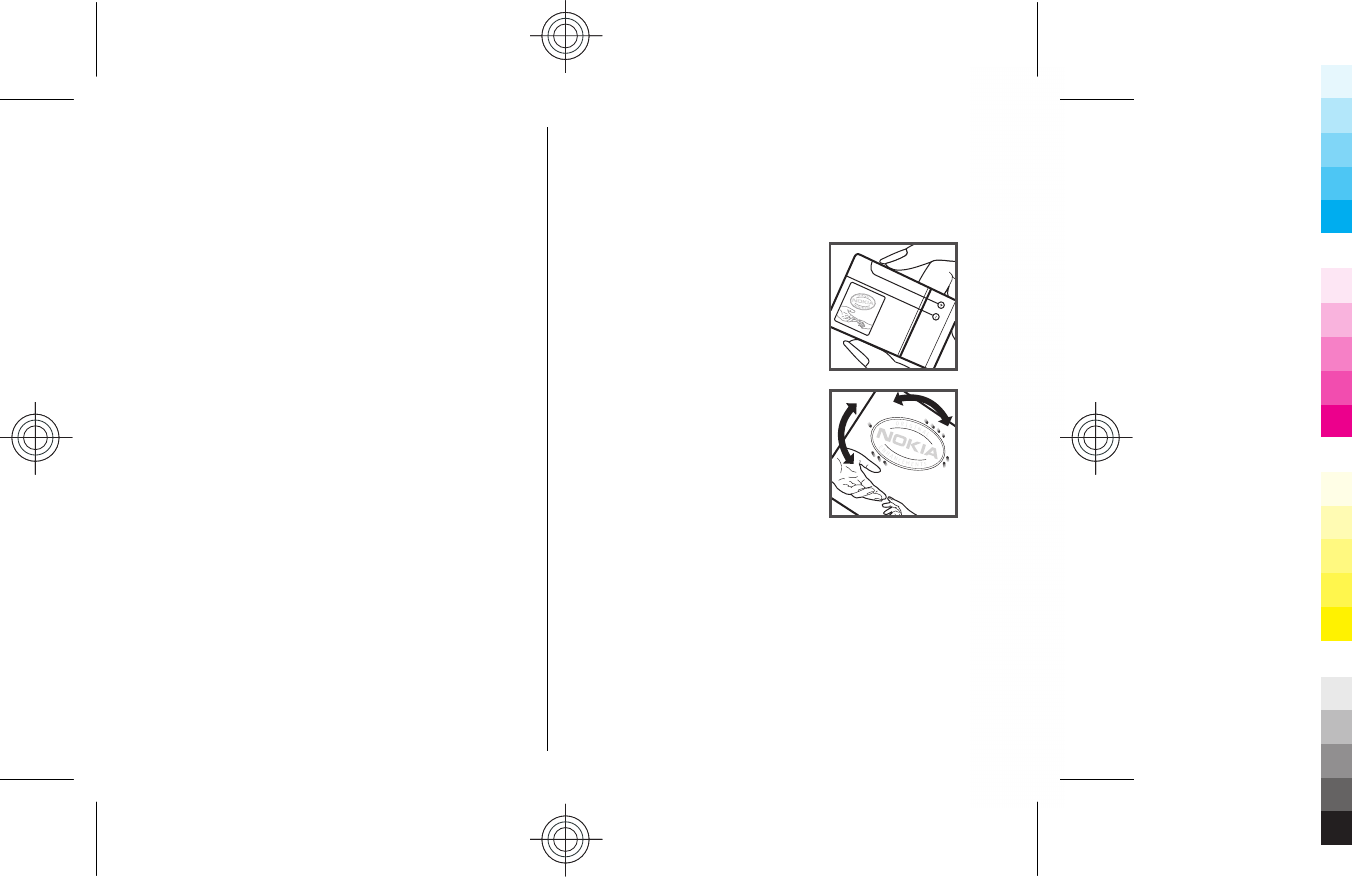
Do not dismantle, cut, open, crush, bend, deform,
puncture, or shred cells or batteries. In the event of a
battery leak, do not allow the liquid to come in contact
with the skin or eyes. In the event of such a leak, flush your
skin or eyes immediately with water, or seek medical help.
Do not modify, remanufacture, attempt to insert foreign
objects into the battery, or immerse or expose it to water
or other liquids.
Improper battery use may result in a fire, explosion, or
other hazard. If the device or battery is dropped, especially
on a hard surface, and you believe the battery has been
damaged, take it to a service centre for inspection before
continuing to use it.
Use the battery only for its intended purpose. Never use
any charger or battery that is damaged. Keep your battery
out of the reach of small children.
Nokia battery
authentication
guidelines
Always use original Nokia batteries for your safety. To
check that you are getting an original Nokia battery,
purchase it from a Nokia authorised service centre or
dealer, and inspect the hologram label using the following
steps:
Successful completion of the steps is not a total assurance
of the authenticity of the battery. If you have any reason
to believe that your battery is not an authentic, original
Nokia battery, you should refrain from using it, and take
it to the nearest Nokia authorised service centre or dealer
for assistance. If authenticity cannot be verified, return the
battery to the place of purchase.
Authenticate hologram
1. When you look at the hologram on
the label, you should see the Nokia
connecting hands symbol from
one angle and the Nokia Original
Enhancements logo when looking
from another angle.
2. When you angle the hologram left,
right, down and up, you should see
1, 2, 3 and 4 dots on each side
respectively.
What if your battery is not
authentic?
If you cannot confirm that your Nokia battery with the
hologram on the label is an authentic Nokia battery, please
do not use the battery. Take it to the nearest Nokia
authorised service centre or dealer for assistance. The use
of a battery that is not approved by Nokia may be
dangerous and may result in poor performance and
damage to your device and its accessories. It may also 71
Battery and charger information
Cyan
Cyan
Magenta
Magenta
Yellow
Yellow
Black
Black
Cyan
Cyan
Magenta
Magenta
Yellow
Yellow
Black
Black

invalidate any approval or warranty applying to the
device.
To find out more about original Nokia batteries, see
www.nokia.com/battery.
72
Battery and charger information
Cyan
Cyan
Magenta
Magenta
Yellow
Yellow
Black
Black
Cyan
Cyan
Magenta
Magenta
Yellow
Yellow
Black
Black

Care and maintenance
Your device is a product of superior design and
craftsmanship and should be treated with care. The
following suggestions will help you protect your warranty
coverage.
•Keep the device dry. Precipitation, humidity, and all
types of liquids or moisture can contain minerals that
will corrode electronic circuits. If your device does get
wet, remove the battery, and allow the device to dry
completely before replacing it.
•Do not use or store the device in dusty, dirty areas. Its
moving parts and electronic components can be
damaged.
•Do not store the device in hot areas. High temperatures
can shorten the life of electronic devices, damage
batteries, and warp or melt certain plastics.
•Do not store the device in cold areas. When the device
returns to its normal temperature, moisture can form
inside the device and damage electronic circuit boards.
•Do not attempt to open the device other than as
instructed in this guide.
•Do not drop, knock, or shake the device. Rough
handling can break internal circuit boards and fine
mechanics.
•Do not use harsh chemicals, cleaning solvents, or strong
detergents to clean the device.
•Do not paint the device. Paint can clog the moving parts
and prevent proper operation.
•Use a soft, clean, dry cloth to clean any lenses, such as
camera, proximity sensor, and light sensor lenses.
•Use only the supplied or an approved replacement
antenna. Unauthorised antennas, modifications, or
attachments could damage the device and may violate
regulations governing radio devices.
•Use chargers indoors.
•Always create a backup of data you want to keep, such
as contacts and calendar notes.
•To reset the device from time to time for optimum
performance, power off the device and remove the
battery.
These suggestions apply equally to your device, battery,
charger, or any enhancement. If any device is not working
properly, take it to the nearest authorised service facility
for service.
Disposal
The crossed-out wheeled-bin symbol on your
product, literature, or packaging reminds you that all
electrical and electronic products, batteries, and
accumulators must be taken to separate collection 73
Care and maintenance
Cyan
Cyan
Magenta
Magenta
Yellow
Yellow
Black
Black
Cyan
Cyan
Magenta
Magenta
Yellow
Yellow
Black
Black

at the end of their working life. This requirement applies
to the European Union and other locations where separate
collection systems are available. Do not dispose of these
products as unsorted municipal waste.
By returning the products to collection you help prevent
uncontrolled waste disposal and promote the reuse of
material resources. More detailed information is available
from the product retailer, local waste authorities, national
producer responsibility organizations, or your local Nokia
representative. For the product Eco-Declaration or
instructions for returning your obsolete product, go to
country-specific information at www.nokia.com.
74
Care and maintenance
Cyan
Cyan
Magenta
Magenta
Yellow
Yellow
Black
Black
Cyan
Cyan
Magenta
Magenta
Yellow
Yellow
Black
Black

Additional safety information
Small children
Your device and its enhancements may contain small
parts. Keep them out of the reach of small children.
Operating environment
This device meets RF exposure guidelines when used
either in the normal use position against the ear or when
positioned at least 2.2 centimetres (7/8 inch) away from
the body. When a carry case, belt clip, or holder is used for
body-worn operation, it should not contain metal and
should position the device the above-stated distance from
your body.
To transmit data files or messages, this device requires a
quality connection to the network. In some cases,
transmission of data files or messages may be delayed
until such a connection is available. Ensure the above
separation distance instructions are followed until the
transmission is completed.
Parts of the device are magnetic. Metallic materials may
be attracted to the device. Do not place credit cards or
other magnetic storage media near the device, because
information stored on them may be erased.
Medical devices
Operation of any radio transmitting equipment, including
wireless phones, may interfere with the functionality of
inadequately protected medical devices. Consult a
physician or the manufacturer of the medical device to
determine if they are adequately shielded from external
RF energy or if you have any questions. Switch off your
device in health care facilities when any regulations
posted in these areas instruct you to do so. Hospitals or
health care facilities may be using equipment that could
be sensitive to external RF energy.
Implanted medical devices
Manufacturers of medical devices recommend that a
minimum separation of 15.3 centimetres (6 inches) should
be maintained between a wireless device and an
implanted medical device, such as a pacemaker or
implanted cardioverter defibrillator, to avoid potential
interference with the medical device. Persons who have
such devices should:
•Always keep the wireless device more than 15.3
centimetres (6 inches) from the medical device when
the wireless device is turned on.
•Not carry the wireless device in a breast pocket. 75
Additional safety information
Cyan
Cyan
Magenta
Magenta
Yellow
Yellow
Black
Black
Cyan
Cyan
Magenta
Magenta
Yellow
Yellow
Black
Black

•Hold the wireless device to the ear opposite the medical
device to minimise the potential for interference.
•Turn the wireless device off immediately if there is any
reason to suspect that interference is taking place.
•Read and follow the directions from the manufacturer
of their implanted medical device.
If you have any questions about using your wireless device
with an implanted medical device, consult your health
care provider.
Hearing aids
Some digital wireless devices may interfere with some
hearing aids. If interference occurs, consult your service
provider.
Vehicles
RF signals may affect improperly installed or inadequately
shielded electronic systems in motor vehicles such as
electronic fuel injection systems, electronic antiskid
(antilock) braking systems, electronic speed control
systems, and air bag systems. For more information, check
with the manufacturer, or its representative, of your
vehicle or any equipment that has been added.
Only qualified personnel should service the device or
install the device in a vehicle. Faulty installation or service
may be dangerous and may invalidate any warranty that
may apply to the device. Check regularly that all wireless
device equipment in your vehicle is mounted and
operating properly. Do not store or carry flammable
liquids, gases, or explosive materials in the same
compartment as the device, its parts, or enhancements.
For vehicles equipped with an air bag, remember that air
bags inflate with great force. Do not place objects,
including installed or portable wireless equipment in the
area over the air bag or in the air bag deployment area. If
in-vehicle wireless equipment is improperly installed and
the air bag inflates, serious injury could result.
Using your device while flying in aircraft is prohibited.
Switch off your device before boarding an aircraft. The use
of wireless teledevices in an aircraft may be dangerous to
the operation of the aircraft, disrupt the wireless
telephone network, and may be illegal.
Potentially explosive
environments
Switch off your device when in any area with a potentially
explosive atmosphere, and obey all signs and instructions.
Potentially explosive atmospheres include areas where
you would normally be advised to turn off your vehicle
engine. Sparks in such areas could cause an explosion or
fire resulting in bodily injury or even death. Switch off the
device at refuelling points such as near gas pumps at
service stations. Observe restrictions on the use of radio
equipment in fuel depots, storage, and distribution areas;
chemical plants; or where blasting operations are in
progress. Areas with a potentially explosive atmosphere
are often, but not always, clearly marked. They include
below deck on boats, chemical transfer or storage facilities
and areas where the air contains chemicals or particles
such as grain, dust, or metal powders. You should check
with the manufacturers of vehicles using liquefied
76
Additional safety information
Cyan
Cyan
Magenta
Magenta
Yellow
Yellow
Black
Black
Cyan
Cyan
Magenta
Magenta
Yellow
Yellow
Black
Black

petroleum gas (such as propane or butane) to determine
if this device can be safely used in their vicinity.
Emergency calls
Important: This device operates using radio signals,
wireless networks, landline networks, and user-
programmed functions. If your device supports voice calls
over the internet (internet calls), activate both the internet
calls and the cellular phone. The device will attempt to
make emergency calls over both the cellular networks and
through your internet call provider if both are activated.
Connections in all conditions cannot be guaranteed. You
should never rely solely on any wireless device for
essential communications like medical emergencies.
To make an emergency call:
1. If the device is not on, switch it on. Check for adequate
signal strength. Depending on your device, you may
also need to complete the following:
•Insert a SIM card if your device uses one.
•Remove certain call restrictions you have activated
in your device.
•Change your profile from offline or flight profile
mode to an active profile.
2. Press the end key as many times as needed to clear the
display and ready the device for calls.
3. Enter the official emergency number for your present
location. Emergency numbers vary by location.
4. Press the call key.
When making an emergency call, give all the necessary
information as accurately as possible. Your wireless device
may be the only means of communication at the scene of
an accident. Do not end the call until given permission to
do so.
Certification
information (SAR)
This mobile device meets guidelines for exposure to
radio waves.
Your mobile device is a radio transmitter and receiver. It
is designed not to exceed the limits for exposure to radio
waves recommended by international guidelines. These
guidelines were developed by the independent scientific
organisation ICNIRP and include safety margins designed
to assure the protection of all persons, regardless of age
and health.
The exposure guidelines for mobile devices employ a unit
of measurement known as the Specific Absorption Rate or
SAR. The SAR limit stated in the ICNIRP guidelines is 2.0
watts/kilogram (W/kg) averaged over 10 grams of tissue.
Tests for SAR are conducted using standard operating
positions with the device transmitting at its highest
certified power level in all tested frequency bands. The
actual SAR level of an operating device can be below the
maximum value because the device is designed to use only
the power required to reach the network. That amount
changes depending on a number of factors such as how
close you are to a network base station. The highest SAR
value under the ICNIRP guidelines for use of the device at
the ear is 1.06 W/kg . 77
Additional safety information
Cyan
Cyan
Magenta
Magenta
Yellow
Yellow
Black
Black
Cyan
Cyan
Magenta
Magenta
Yellow
Yellow
Black
Black

Use of device accessories may result in different SAR
values. SAR values may vary depending on national
reporting and testing requirements and the network
band. Additional SAR information may be provided under
product information at www.nokia.com.
78
Additional safety information
Cyan
Cyan
Magenta
Magenta
Yellow
Yellow
Black
Black
Cyan
Cyan
Magenta
Magenta
Yellow
Yellow
Black
Black
Your mobile device is also designed to meet the
requirements for exposure to radio waves established
by the Federal Communications Commission (USA) and
Industry Canada. These requirements set a SAR limit of
1.6 W/kg averaged over one gram of tissue. The highest
SAR value reported under this standard during product
certification for use at the ear is 1.06 W/kg and when
properly worn on the body is 0.62 W/kg .

Index
A
access points
creating 65
VPN 60
Active notes 44
alarm clock 47
alert tones 62
animated screen saver 43
application settings 67
applications
installing 58
attachments
e-mail 24
sound clips 27
autolock period 63
B
background image 43
backing up data 57
Bluetooth
authorising devices 49
pairing 49
passcode 49
receiving data 49
security 50
sending data 49
bookmarks 29
browsing
intranet 29
offline 29
web 28
C
cable 48
cache
emptying 29
Calculator 44
Calendar
settings 12
calendar entries
creating 11
viewing 11
calendar key 11
calendar views
changing 11
caller ID 64
calls
answering 16
call waiting 64
caller ID 64
conference call 17
making 16
making a net call 19
muting the ringing tone 16
net call alert 64
rejecting 16
rejecting with text message 64
selecting type 64
settings 64
speed dialling 20
voice mail 20
camera
capturing images 36
recording video clips 36
certificates
details 57
settings 57
Clock
alarms 47
settings 47
conference calls 17
configuration messages 66
connection methods
Bluetooth 49
data cable 48
connections
ending 53
GPRS settings 30
PC connection 31
WLAN settings 31
contact groups
adding ringing tones 13
creating 13
making conference calls 13
contacts
adding 13
adding ringing tones 13
searching 13
settings 13
contacts directories
managing 13
79
Index
Cyan
Cyan
Magenta
Magenta
Yellow
Yellow
Black
Black
Cyan
Cyan
Magenta
Magenta
Yellow
Yellow
Black
Black

contacts key 10
converting
currencies 46
measurements 45
currency conversions 46
D
date
settings 62
decrypting
device memory and memory
card 56
display
changing the look 43
settings 61
Download!
managing items 30
E
e-mail
connecting to mailbox 24
deleting 25
POP or IMAP 23
replying 24
sending 25
setting up 23
writing 25
e-mail key 11
e-mail key settings 63
encrypting
device memory and memory
card 56
ending
internet connections 29
network connections 53
enhancements
settings 63
F
File manager 45
files
flash files 39
sending 45
Flash player 39
flashlight 14
free memory 54
G
GPRS
access point settings 30
settings 65
H
home key 10
home screen 9
settings 43, 61
switching 10
I
IM 27
images
rotating 38
sharing online 38
zooming 38
installation log 58
installing
applications 58
Instant messaging 27
internet 28
ending connections 29
internet calls 19
Internet radio
listening 40
saving stations 40
searching 40
settings 41
intranet
browsing 29
J
jad files 58
jar files 58
Java applications 58
K
keypad
lock settings 63
tones 62
keys
shortcuts 61
L
language
settings 62
lock code 54, 63
locking
device 54
device autolock 63
keypad 63
logos
operator logo 61
welcome logo 61
80
Index
Cyan
Cyan
Magenta
Magenta
Yellow
Yellow
Black
Black
Cyan
Cyan
Magenta
Magenta
Yellow
Yellow
Black
Black

M
mailboxes
connecting 24
creating 23
making a call 16
Maps 33
browsing 34
finding locations 34
indicators 34
routes 35
measurements
converting 45
memory 54
memory card
backing up data 57
formatting 55
locking 55
microSD 55
passwords 55
setting password 45, 55
unlocking 55
messages
call rejection messages 64
configuration messages 66
sending sound clips 27
text message settings 25
microSDHC 55
modem 31
multimedia messages
creating 26
sending 26
multitasking 14
Music player
Music Store 37
playing 37
transferring music 38
Music Store 37
N
net calls
alert settings 64
connecting 19
making a call 19
profiles 19, 66
settings 66
network
settings 64
notification light 62
O
One-touch keys 62
operator
logo 61
selecting 64
original settings 64
P
packet data
access point settings 30
restricting 67
settings 65
pairing
devices 49
passcode 49
passwords
memory card password 45, 55
PDF reader 46
personalisation 43
changing language 62
display 61
home screen 61
tones 62
PIN code
changing 63
predictive text input 62
printing 46
profiles
creating 42
customising 42
net call profile 19, 66
selecting ringing tones 42
Q
Quickoffice 45
R
radio
listening to 39
recorder 38
recording
video clips 36
remote lock 54
remote synchronisation 59
restoring original settings 64
ringing tones 62
contacts and contact groups 13
in profiles 42
vibrating alert 62
S
screen saver 43, 61 81
Index
Cyan
Cyan
Magenta
Magenta
Yellow
Yellow
Black
Black
Cyan
Cyan
Magenta
Magenta
Yellow
Yellow
Black
Black

search modes
switching 13
searching
available WLANs 53
security
Bluetooth 50
device and SIM card 63
memory card 55
sending
files 45
using Bluetooth 49
videos 18
session initiation protocol
See
SIP
settings
applications 67
Calendar 12
calls 64
certificate 57
clock 47
contacts 13
date 62
display 61
e-mail key 63
enhancements 63
GPRS 30, 65
home screen 61
Internet radio 41
keypad lock 63
language 62
net call 66
network 64
packet data 65
restoring 64
SIP 66
text messages 25
time 62
tones 62
web 29
WLAN 65
WLAN access point 31
WLAN security 66
shortcuts 68
keys 61
SIP
creating profiles 66
editing profiles 66
settings 66
sis files 58
sisx files 58
software packages
installing 58
sound clips 38
sending 27
speed dialling 20
standby mode
settings 61
Symbian applications 58
synchronisation
synchronisation profiles 59
T
text
changing size 61
text messages
sending 25
settings 25
writing 25
themes
changing 43
time
settings 62
tones 62
settings 62
U
UPIN code
changing 63
USB data cable 48
V
vibrating alert 62
video calls
making a call 17
switching to voice call 17
video clips 36
video sharing 18
receiving invitations 18
virtual private network
access points 60
use in applications 60
voice mail
calling 20
changing number 20
VPN
access points 60
use in applications 60
W
warning tones 62
Web
connection security 28
web
settings 29
82
Index
Cyan
Cyan
Magenta
Magenta
Yellow
Yellow
Black
Black
Cyan
Cyan
Magenta
Magenta
Yellow
Yellow
Black
Black
